- International edition
- Australia edition
- Europe edition
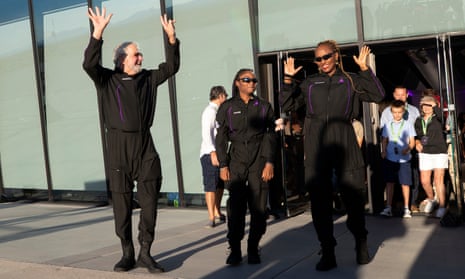

Virgin Galactic successfully flies tourists to space for first time
Six individuals were aboard VSS Unity space plane, including first mother-daughter duo to venture to space together
Virgin Galactic’s VSS Unity, the reusable rocket-powered space plane carrying the company’s first crew of tourists to space, successfully launched and landed on Thursday.
The mission, known as Galactic 02, took off shortly after 11am ET from Spaceport America in New Mexico .
Aboard the spacecraft were six individuals total – the space plane’s commander and former Nasa astronaut CJ Sturckow, the pilot Kelly Latimer, as well as Beth Moses, Virgin Galactic’s chief astronaut instructor who trained the crew before the flight.
The spacecraft also carryied three private passengers, including the health and wellness coach Keisha Schahaff and her 18-year-old daughter, Anastasia Mayers, both of whom are Antiguan.
According to Space.com, Schahaff won her seat onboard the Galactic 02 as part of a fundraising competition by Space for Humanity, a non-profit organization seeking to democratize space travel. Mayers is studying philosophy and physics at Aberdeen University in Scotland. Together, Schahaff and Mayers are the first mother-daughter duo to venture to space together.
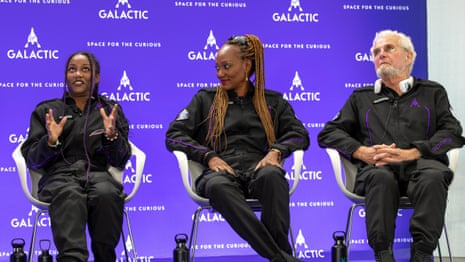
“When I was two years old, just looking up to the skies, I thought, ‘How can I get there?’ But, being from the Caribbean, I didn’t see how something like this would be possible. The fact that I am here, the first to travel to space from Antigua, shows that space really is becoming more accessible,” Schahaff said in a statement last month.
The mission also marks the most women flown in a single mission to space.
Onboard the flight was also the former Olympian Jon Goodwin, who participated in the 1972 Olympics in Munich as a canoeist. At 80 years old, Goodwin was the second passenger with Parkinson’s disease and the first Olympian to embark on a trip to space.
“When I was diagnosed with Parkinson’s in 2014, I was determined not to let it stand in the way of living life to the fullest. And now for me to go to space with Parkinson’s is completely magical,” he said in a news release. “I hope this inspires all others facing adversity and shows them that challenges don’t have to inhibit or stop them from pursuing their dreams,” Goodwin said .
Galactic 02 is a suborbital flight. However, despite VSS Unity not reaching orbit, the trajectory allows passengers to experience several minutes of weightlessness at an altitude high enough for them to see the Earth’s curvature, Space.com explains .
Following liftoff, Virgin Galactic’s carrier plane VMS Eve transported VSS Unity to an altitude of about 44,300ft. Eve then dropped Unity, which then fired its own rocket motor and ascended to suborbital space. Passengers onboard experienced approximately 3Gs.
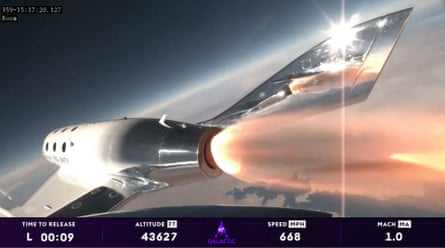
Live footage inside the spacecraft showed the passengers unstrapping themselves from their seats and peering out down to Earth through the windows as they floated throughout the spacecraft.
In a press conference after the flight, Schahaff recounted her experience, saying: “Looking at Earth was the most amazing … It was so comfortable. It really was the best ride ever. I would love to do this again.
“This experience has given me this beautiful feeling that if I can do this, I can do anything,” she added.
Mayers, who is the second-youngest person to go to space, said: “I was shocked at the things that you feel. You are so much more connected to everything than you would expect to be. You felt like a part of the team, a part of the ship, a part of the universe, a part of Earth. It was incredible and I’m still starstruck.”
To Goodwin, the experience was far more dramatic than he expected.
after newsletter promotion
“The pure acceleration, Mach 3 [2,301mph, 3,378 ft per second] in eight and a half seconds was completely surreal. The re-entry was a lot more dramatic than I imagined it would be. In fact, I would have said it was out of control if I didn’t know anything different,” he said.

“It was a completely surreal experience. But the most impressive thing was looking at Earth from space. The pure clarity was very moving, quite surreal. It was without a doubt the most exciting day of my life,” he added.
In a statement released following the flight, Sturckow said: “It is a surreal and humbling experience to have flown Unity today. The wonder and excitement of spaceflight never loses its magic.”
Latimer echoed similar sentiments, saying: “In my entire career, from the Air Force Academy to being a test pilot for Nasa, nothing tops what I have just experienced at the controls of VSS Unity. Going to space today fulfilled an ambition I’ve had since I was a child.”
The Virgin Galactic founder, Sir Richard Branson, also hailed the flight, tweeting: “Today we flew three incredible private passengers to space: Keisha Schahaff, Anastatia Mayers and Jon Goodwin. Congratulations Virgin Galactic commercial astronauts 011, 012 and 013 – welcome to the club!”
Despite Galactic 02 being Virgin Galactic’s second commercial spaceflight mission, it is the first flight to carry private customers. In June, Galactic 01 carried three crew members from the Italian air force and the National Research Council of Italy.
In July 2021, Branson traveled to space and back onboard the VSS Unity, a mission that marked the billionaire’s entry into the new era of space tourism helmed by other billionaires including the SpaceX founder, Elon Musk, and Blue Origin founder, Jeff Bezos.
According to Virgin Galactic, the company has already booked a backlog of about 800 customers. Tickets have ranged from $250,000 to $450,000.
Galactic 03, the company’s third commercial spaceflight, is planned for September.
- Virgin Galactic
Most viewed
Want to travel to Mars? Here’s how long the trip could take.
Nuclear engines or not, you're gonna need a lot of PTO to get to the Red Planet.
By Eva Botkin-Kowacki | Published Feb 21, 2023 6:00 AM EST

Despite what Star Trek’s warp-speed journeys would have us believe, interplanetary travel is quite the hike. Take getting to Mars. Probes sent to the Red Planet by NASA and other space agencies spend about seven months in space before they arrive at their destination. A trip for humans would probably be longer—likely on the timescale of a few years.
There are a lot of things that a human crew needs to survive that robots don’t, such as food, water, oxygen, and enough supplies for a return—the weight of which can slow down a spacecraft. With current technology, NASA calculations estimate a crewed mission to Mars and back, plus time on the surface , could take somewhere between two and three years. “Three years we know for sure is feasible,” says Michelle Rucker, who leads NASA’s Mars Architecture Team in the agency’s Human Exploration and Operations Mission Directorate .
But NASA aims to shorten that timeline, in part because it would make a Mars mission safer for humans—we still don’t know how well the human body can withstand the environment of space for an extended period. (The record for most consecutive days in space is 437.) The agency is investing in projects to develop new propulsion technologies that might enable more expeditious space travel.
A crooked path to Mars
In a science-fictional world, a spacecraft would blast off Earth and head directly to Mars. That trajectory would certainly make for a speedier trip. But real space travel is a lot more complicated than going from point A to point B.
“If you had all the thrust you want, you could ignore the fact that there happens to be gravity in our universe and just plow all the way through the solar system,” says Mason Peck , a professor of astronautics at Cornell University who served as NASA’s chief technologist from 2011 to 2013. “But that’s not a scenario that’s possible right now.”
Such a direct trajectory has several challenges. As a spacecraft lifts off Earth, it needs to escape the planet’s gravitational pull, which requires quite a bit of thrust. Then, in space, the force of gravity from Earth, Mars, and the sun pulls the spacecraft in different directions. When it is far enough away, it will settle into orbit around the sun. Bucking that gravity requires fuel-intensive maneuvers.
[Related: Signs of past chemical reactions detected on Mars ]
The second challenge is that the planets do not stay in a fixed place. They orbit the sun, each at its own rate: Mars will not be at the same distance from Earth when the spacecraft launches as the Red Planet will be, say, seven months later.
As such, the most fuel-efficient route to Mars follows an elliptical orbit around the sun, Peck says. Just one-way, that route covers hundreds of millions of miles and takes over half a year, at best.
But designing a crewed mission to the Red Planet isn’t just about figuring out how fast a spacecraft can get there and back. It’s about “balance,” says Patrick Chai, in-space propulsion lead for NASA’s Mars Architecture Team . “There are a whole bunch of decisions we have to make in terms of how we optimize for certain things. Where do we trade performance for time?” Chai says. “If you just look at one single metric, you can end up making decisions that are really great for that particular metric, but can be problematic in other areas.”
One major trade-off for speed has to do with how much stuff is on board. With current technology, every maneuver to shorten the trip to Mars requires more fuel.
If you drive a car, you know that in order to accelerate the vehicle, you step on the gas. The same is true in a spacecraft, except that braking and turning also use fuel. To slow down, for instance, a spacecraft fires its thrusters in the opposite direction to its forward motion.
But there are no gas stations in space. More fuel means more mass on board. And more mass requires more fuel to propel that extra mass through the air… and so on. Trimming a round-trip mission down to two years is when this trade-off starts to become exponentially less efficient, Rucker says. At least, that’s with current technology.
New tech to speed up the trip
NASA would like to be able to significantly reduce that timeline. In 2018, the space agency requested proposals for technological systems that could enable small, uncrewed missions to fly from Earth to Mars in 45 days or less .
At the time, the proposals didn’t gain much traction. But the challenge inspired engineers to design innovative propulsion systems that don’t yet exist. And now, NASA has begun to fund the development of leading contenders. In particular, the space agency has its eye on nuclear propulsion.
Spacecraft currently rely largely on chemical propulsion. “You basically take an oxidizer and a fuel, combine them, and they combust, and that generates heat. You accelerate that heated product through a nozzle to generate thrust,” explains NASA’s Chai.
Engineers have known for decades that a nuclear-based system could generate more thrust using a significantly smaller amount of fuel than a chemical rocket. They just haven’t built one yet—though that might be about to change.
One of NASA’s nuclear investment projects aims to integrate a nuclear thermal engine into an experimental spacecraft. The Demonstration Rocket for Agile Cislunar Operations , or DRACO, program, is a collaboration with the Defense Advanced Research Projects Agency (DARPA), and aims to demonstrate the resulting technology as soon as 2027 .
[Related: Microbes could help us make rocket fuel on Mars ]
The speediest trip to Mars might come from another project, however. This concept, the brainchild of researchers at the University of Florida and supported by a NASA grant, seeks to achieve what Chai calls the “holy grail” of nuclear propulsion: a combination system that pairs nuclear thermal propulsion with an electric kind.
“We did some preliminary analysis, and it seems like we can get pretty close to [45 days],” says the leader of that project, Ryan Gosse, a professor of practice in the University of Florida’s in-house applied research program, Florida Applied Research in Engineering (FLARE). One caveat: That timeline is for a light payload and no humans on board. However, if the project is successful, the technology could potentially be scaled up in the future to support a crewed mission.

There are two types of nuclear propulsion, and both have their merits. Nuclear thermal propulsion, which uses heat, can generate a lot of thrust quickly from a small amount of fuel. Nuclear electric propulsion, which uses charged particles, is even more fuel-efficient but generates thrust much more slowly.
“While you’re in deep space, the electric propulsion is really great because you have all the time in the world to thrust. The efficiency, the miles per gallon, is far, far superior than the high-thrust,” Chai says. “But when you’re around planets, you want that oomph to get you out of the gravity well.”
The challenge, however, is that both technologies currently require different types of nuclear reactors, says Gosse. And that means two separate systems, which reduces the efficiency of having a nuclear propulsion system. So Gosse and his team are working to develop technology that can use the one system to generate both types of propulsion.
NASA’s Mars architecture team is also working with a bimodal concept that uses a chemical propulsion system to maneuver around planets and solar-powered electric propulsion to do the thrusting in deep space.
“What we are developing is different tools for the toolbox,” says NASA’s Rucker. “One tool isn’t going to be enough to do all of the exploration that we want to do. So we’re working on all of these.”
Like science, tech, and DIY projects?
Sign up to receive Popular Science's emails and get the highlights.
- Search Please fill out this field.
- Manage Your Subscription
- Give a Gift Subscription
- Sweepstakes
- Space Travel + Astronomy
Space Tourism Is Here: Booking a Trip to the Final Frontier
The next era of space exploration and innovation is here — and we're all invited. A billionaire space race is underway as Blue Origin, Virgin Galactic, SpaceX, and others are testing the technology to take us to places previously visited only by highly trained astronauts. Space tourism is officially taking flight, and it might just save the Earth.
:max_bytes(150000):strip_icc():format(webp)/Jamie-Carter-618d9aa6e45f4ecf9b9dcaabbec68029.jpg)
In July 2021, we watched as Richard Branson and Jeff Bezos took to the skies in a giant leap for the space tourism industry, but their launches to the edge of space weren't timed particularly well. Against the backdrop of a global pandemic and climate emergency, two billionaires taking joy rides to space may not have been good optics, but don't underestimate what just happened — and how important it could be for the future of humanity.
With the first crewed launches of Virgin Galactic's supersonic space plane and Blue Origin's reusable rocket, a world of commercial space travel is taking its first step. Both companies plan to begin regular, scheduled trips for paying space tourists in the near future, but their visions stretch back many years to the beginning of human spaceflight.
The Space Race: Then and Now
Bezos's Blue Origin chose an auspicious day to send its first crew to space. July 20, 2021 was exactly 52 years after Apollo 11 astronauts Neil Armstrong and Buzz Aldrin became the first humans to walk on the moon. But that wasn't the only major space travel anniversary celebrated in 2021.
April 12 was the 60th anniversary of Russian cosmonaut Yuri Gagarin becoming the first human to not only reach space, but also go into orbit around Earth. Meanwhile, May 5 saw the 60th anniversary of NASA's Freedom 7 mission, which launched Alan Shepard on a suborbital flight that lasted 15 minutes. He reached an altitude of 101 miles to become the first American in space before his capsule parachuted to splashdown in the ocean.
The name of Blue Origin's New Shepard launch system is no coincidence. Its mission profile is almost identical to America's inaugural 1961 spaceflight, save for billionaire-grade comfy seats and large windows. From Launch Site One near Van Horn in the West Texas desert, that rocket fires a capsule containing up to six people (but no pilot) into space, which then parachutes down 15 minutes later.
The Virgin Galactic experience is different. Its supersonic rocket-powered spaceplane SpaceShipTwo VSS Unity seats six passengers and two highly trained pilots. It takes off on a runway from Spaceport America near Truth or Consequences, New Mexico, while strapped to a mothership. At 52,000 feet, it detaches and burns its rocket engine for one minute to reach Mach 3 speeds and touch the edge of space. After a few minutes of weightlessness (and a chance for passengers to see the curvature of Earth against the blackness of space), it glides back to land on a runway.
The Price for a Ticket to Space
These short trips are anticipated to cost between $250,000 and $500,000, but in January 2022, expect to see a truly out-of-this-world private trip to space with an even more astronomical price tag. It will come from the other, arguably much more important billionaire in the space tourism bubble: Elon Musk. Axiom Mission 1 will see his company, SpaceX, launch four private astronauts on behalf of Houston-based space tourism company Axiom Space. An American real estate investor, a Canadian investor, a former Israeli Air Force pilot, and an ex-Space Shuttle pilot will launch on an incredible orbital mission in its Crew Dragon spacecraft.
At $55 million per ticket, this is ultra-aspirational space tourism of the highest order. "The experience is drastically different because they will be launching on a SpaceX rocket and going to the International Space Station (ISS) for 10 days," says Christina Korp, cofounder of Space for a Better World . "They will be doing what real astronauts do, and I don't think it's an accident that Virgin Galactic and Blue Origin did their flights before Axiom's mission." Axiom Space intends to launch a private space station — the first "space hotel" — as early as 2024 to give space tourists somewhere to visit.
The Future of Space Tourism — and of Our Planet
Musk talks of Mars colonies and humanity spreading out into the cosmos, but since 2012, SpaceX has made a lot of money from NASA contracts to launch supplies to the ISS. In the summer of 2020, it began ferrying NASA astronauts there, too. SpaceX's Starship — currently being tested — will land two NASA astronauts, the first woman and the next man, on the moon in 2024.
You see, space tourism is just a sideshow to a bigger and more worthy goal of saving the planet. Next year, Blue Origin plans to test its reusable New Glenn rocket — named after John Glenn, the first American to orbit the Earth in 1962 — which will be able to take cargo and astronauts into orbit. Bezos has said he thinks we need to go to space to save Earth, specifically by protecting the planet from pollution by moving heavy industry into space. That can only happen when space travel is safe, scheduled, and affordable. Space tourism will help create a competitive space economy, just as mass tourism has lowered the cost of flying.
Similarly, Branson's aim is to increase access to space. "We are at the vanguard of a new space age…Our mission is to make space more accessible to all," he said after his inaugural flight. A microgravity experiment was on board that first flight on July 11, with similar plans for all subsequent trips. Meanwhile, sister company Virgin Orbit's LauncherOne sends small satellites and science payloads into orbit via a small rocket launch from underneath the wing of a Boeing 747.
The scientific spin-offs for all of us down on Earth are currently unknown, but the space community has an incredible track record when it comes to innovation. "Clean energy as solar power is from the space program," says Korp. "Solar panels were invented to power satellites and refined to power spacecraft." Cue GPS, weather forecasting, telecommunications, and even internet access. There are also fleets of satellites large and small that observe how our planet is behaving and changing. "It's the space industry that's monitoring climate change, tracking hurricanes, and learning how to survive in the extreme environment of space — including experiments to grow food with almost no water, for example," says Korp. Every single space mission, including suborbital and even zero-gravity flights, have environmental experiments on board as default.
"This is not about escaping Earth," said Bezos after the flight. "The whole point is, this is the only good planet in the solar system and we have to take care of it." Bezos wants to scale up into affordable space travel. That will enable long-term, commercial projects that ultimately may help prevent further climate change, or at least help us cope with its consequences.
However, Blue Origin, Virgin Galactic, and SpaceX won't be the only way to reach space. Russian space agency Roscosmos is expected to take "citizen space explorers" to the ISS soon, but the most affordable way to get "black sky time" may be with Space Perspective , which will launch a pressurized capsule propelled by a high-performance space balloon.
The six-hour flight will cost around $125,000 per person and launch from Space Coast Spaceport in Florida in 2024. "Unlike short-lived, adrenaline-fueled moments of weightlessness, Space Perspective flights bring you space calm," says Jane Poynter, founder, co-CEO, and CXO of Space Perspective. The flights on Spaceship Neptune involve a gentle ascent at just 12 miles per hour for a six-hour tour of Earth's biosphere, culminating in a view of our beautiful planet from space.
Space tourism is here at last. Instagram had better get ready for "Earth selfies."
Program Credits
Editorial Lead: Elizabeth Rhodes Contributors: Jamie Carter and Stefanie Waldek Visuals Editor: Mariah Tyler Art Director: Jenna Brillhart Designer: Sarah Maiden
New Shepard is a fully reusable rocket launching a new generation of astronauts.
Launch to space on a rocket
Named for Alan Shepard, the first U.S. astronaut, New Shepard launches from the high West Texas desert. On your 11-minute flight, you'll travel over 3X the speed of sound to pass the Kármán Line at 100 km (62 mi), float weightless for several minutes, and witness life-changing views of Earth before descending gently under parachutes.
A fully reusable booster
New Shepard is 100% reusable and fully autonomous. The booster and capsule are designed to launch more than 25 times. The high-performing engine runs clean with water vapor as the only exhaust, and no carbon emissions.
The Capsule
See Earth from your own epic window seat
With room for six astronauts, the spacious and pressurized cabin is climate-controlled for your comfort. Every passenger gets their own window seat for unprecedented views of Earth. The windows comprise over one third of the capsule's surface area.
Flight Training
Fully train for flight in just two days
While onsite you'll learn everything you need for a safe and life-changing space flight. You and your crew will meet the rocket up close, experience missions in the capsule simulator, and learn about safety and zero-g protocols for your weightless journey.
Your journey begins at Launch Site One
Nestled in the Guadalupe Mountains, two hours east of El Paso, Launch Site One sits on the historic Figure 2 Ranch near Van Horn, Texas. You and your crew will stay onsite at the Astronaut Village. Spectacular sunrises, sunsets, and stargazing abound. This is where your dreams of reaching space will become a reality.
Commitment to Safety
22 successful flights, 22 safe landings
Blue Origin has been flight testing the New Shepard rocket and its triple-redundant safety systems since 2012. The program has had 22 successful consecutive missions including three successful capsule escape tests, demonstrating the crew escape system can activate safely in any phase of flight.
What Astronauts Say
Hear what it's like from our astronauts
New Shepard has launched both the oldest and youngest people ever to go to space, William Shatner and Oliver Daemen. Hear from Oliver as he recalls his life changing experience aboard New Shepard.
It's your time. Join the new generation of astronauts.
© 2007 - 2023 Blue Origin, All Rights Reserved.
- Skip to main content
- Keyboard shortcuts for audio player
3 predictions for the future of space exploration — including your own trips

Alejandra Marquez Janse

Mary Louise Kelly
Tinbete Ermyas

Peggy Whitson says more widely available space tourism is realistic. Axiom Space hide caption
Peggy Whitson says more widely available space tourism is realistic.
If you've ever traveled somewhere that left you so enthralled that you wanted to go back over and over, then you get how Peggy Whitson feels about space.
She is a seasoned astronaut who has multiple achievements under her belt: She was the first woman to command the International Space Station, and in 2017 broke the record for most cumulative days in space of any American and female astronaut, with a count of 665.
Whitson retired from NASA nearly five years ago, but last month, at age 63, she packed up the necklace she wore on her wedding day, zipped her spacesuit one more time, and took flight in a SpaceX capsule as commander of the Ax-2 mission. It was sponsored by a private company, Axiom Space, where she now works as the director of human spaceflight. Three paying crew members traveled with her.
After returning to Earth, Whitson spoke with All Things Considered host Mary Louise Kelly and shared a few thoughts about the future of space exploration.
This interview has been edited slightly for clarity and brevity.

The Ax-2 crew in a training session. The group, composed of Whitson (far left) and three paying costumers, spent nine days in space last month. Axiom Space hide caption
The Ax-2 crew in a training session. The group, composed of Whitson (far left) and three paying costumers, spent nine days in space last month.
1. Space exploration will be a mix of public and private money
If you look at even the NASA missions returning to the moon, lots of different private space companies are involved in that process. And that includes Axiom Space, for instance, who are building the spacesuits that will be used by the NASA astronauts as they step on the moon again. So it's exciting to be part of this changing philosophy of space and the efforts of commercial companies like Axiom Space. We intend to build the first commercial space station initially attached to the International Space Station, but to undock before the space station is decommissioned.
I think it's a worldwide relationship between different companies and peoples, and that's what makes it such a special time to be a part of the [Ax-2] mission, because [space exploration] is changing flavor and it's exciting because there are going to be many more opportunities in the future.

The Ax-2 crew returns to Earth. Could this be you one day? Axiom Space hide caption
2. More people will be able to go to space
Obviously some of it will take time to make it not cost-prohibitive, but the fact that we are taking those initial steps is really important now. If you look back at commercial aviation and how that occurred and the development of that process, you know, it also started off to be only a few people could be involved and then later more and more, and so now it's pretty commonplace. I like to think that we're doing some of the same steps in commercial spaceflight now.
3. The goals depend on the person — and the country — that's traveling
Well, the objective of the mission is slightly different, obviously. My personal roles and responsibilities of taking care of the crew and ensuring their safety obviously are very similar. But our objectives were, we had one private astronaut, John Shoffner, who was trying to develop science, technology, engineering and math (STEM) outreach products for educators in the future, as well as doing research. And then we had two government sponsored astronauts from Saudi Arabia – the first female Saudi Arabian to fly in space and go to the International Space Station – and the second male to arrive.

SpaceX mission returns from space station with ex-NASA astronaut, 3 paying customers
So the objectives of the crew weren't all that much different necessarily than a NASA mission, which is outreach and scientific investigations, but these were with the specific goals of expanding outreach in specific areas for Saudi – which hadn't had a person in space for 40 years – and, you know, to inspire their youth as well as inspiring the youth in the United States.
The Nuclear Thermal Rocket That Could Get Us to Mars in Just 45 Days
The path to higher thrust propulsion starts here.

- NASA has hired Lockheed Martin to design, build, and test a nuclear-powered rocket for space travel.
- The technology could speed up a manned trip to Mars from the current seven-month minimum to as few as 45 days.
- A nuclear fission reactor would power the rocket’s engine for nuclear propulsion.
NASA and the U.S. Department of Defense’s Defense Advanced Research Projects Agency (DARPA) contracted Lockheed Martin to design, build, and test nuclear thermal rocket technology for a shorter, faster trip to the Red Planet. The rocket is also expected to operate with twice the efficiency as conventional chemical rockets, which combine fuel and an oxidizer for combustion power.
“Working with DARPA and companies across the commercial space industry will enable us to accelerate the technology development we need to send humans to Mars,” Pam Melroy, NASA deputy administrator, says in a statement . “This demonstration will be a crucial step in meeting our Moon-to-Mars objectives for crew transportation into deep space.”
Lockheed Martin will lead spacecraft design, integration, and testing of the roughly $500 million project, and BWX Technologies will design and build the nuclear fission reactor to power the engine.
Tabitha Dodson, DARPA program manager for the project, says in a statement that the DRACO project (Demonstration Rocket for Agile Cislunar Operations) “aims to give the nation leap-ahead propulsion capability.”
A nuclear thermal rocket could achieve high thrust—much like chemical propulsion—but is up to three times more efficient. This means that instead of the seven month-minimum it now takes to get to Mars , a nuclear-powered trip would only take 45 days . And going to Mars in 45 days isn’t the only benefit, as NASA is also looking for an efficient Earth-to-Moon connection.
“In order for our country, for our species, to further explore space, we need changes in more efficient propulsion,” Kirk Shireman, Lockheed Martin’s vice president for lunar exploration campaign, said in a press conference, according to the Washington Post . “Higher thrust propulsion is really, really important. And I think we’re on the cusp of that here.”
The United States started down the nuclear rocket path in the 1950s, but the idea was scraped during a 1970s budget cut. The DRACO program aims to build on that early research, but with a new fuel option for fewer logistical hurdles. Using a high-assay, low-enriched uranium fuel, the fission -based reactor can split apart atoms, heat up liquid hydrogen, and shoot that high-temperature gas through an engine nozzle for the needed thrust.
The greater efficiency from a nuclear thermal rocket not only slashes transit time, but also reduces astronaut risks and cuts down on payload needs for both supplies and systems.
One challenge yet to be overcome, according to Live Science , is the need to heat the hydrogen to 4,400°F while also storing it a minus-420°F. “This is just as much a demonstration of on-orbit storage of cryogenic liquid hydrogen as it is a demo of the nuclear thermal rocket,” Dodson says.
In the hoped-for 2027 test launch, the engine’s fission reactor will stay turned off—for obvious safety reasons—until the rocket reaches its designated orbit. The U.S. Space Force will provide a launch vehicle to take the test vessel into space.
The initial DRACO test plans to send the craft at least 435 miles and no more than 1,240 miles into space. It has no planned maneuvers, and will instead allow the vehicle’s reactor to use the new fuel and collect data along the way. With a planned two months of liquid hydrogen stored on the craft, crews may also test, according to Space News , the possibility of an in-space refueling.
“We’re going to put this together,” Shireman told reporters, according to Live Science , “we’re going to fly this demonstration, gather a bunch of great data and really, we believe, usher in a new age for the United States [and] humankind, to support our space exploration mission.”
Tim Newcomb is a journalist based in the Pacific Northwest. He covers stadiums, sneakers, gear, infrastructure, and more for a variety of publications, including Popular Mechanics. His favorite interviews have included sit-downs with Roger Federer in Switzerland, Kobe Bryant in Los Angeles, and Tinker Hatfield in Portland.

.css-cuqpxl:before{padding-right:0.3125rem;content:'//';display:inline;} Moon and Mars .css-xtujxj:before{padding-left:0.3125rem;content:'//';display:inline;}
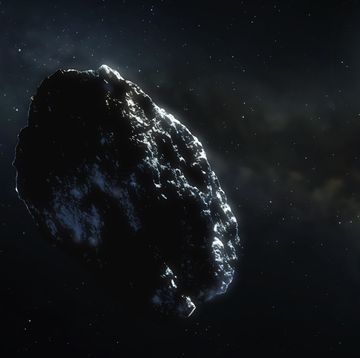
How to View the Solar Eclipse

How a Lunar Supercollider Could Upend Physics

The Moon Is Going Nuclear
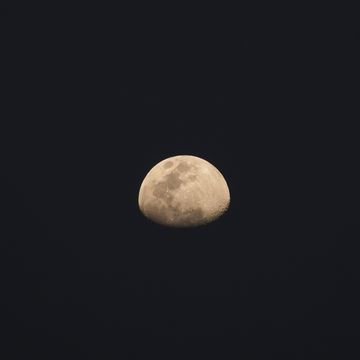
Private Company to Mine Helium-3 from the Moon
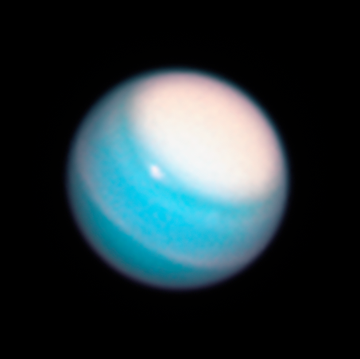
3 Moons Emerged From Around Neptune and Uranus

4 People Are Spending a Year In a Martian World.

America Has Planted Its Feet on the Moon Once More

The Strange Origin of the Hollow Moon Conspiracy

The Moon Is Shrinking Where We're Trying to Land
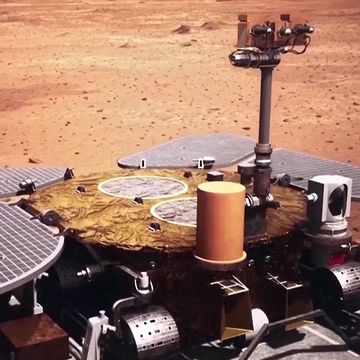
Rover Reveals Bizarre Shapes on Martian Surface

Ingenuity Has Made Its Final Flight on Mars.

Universe Today
Space and astronomy news
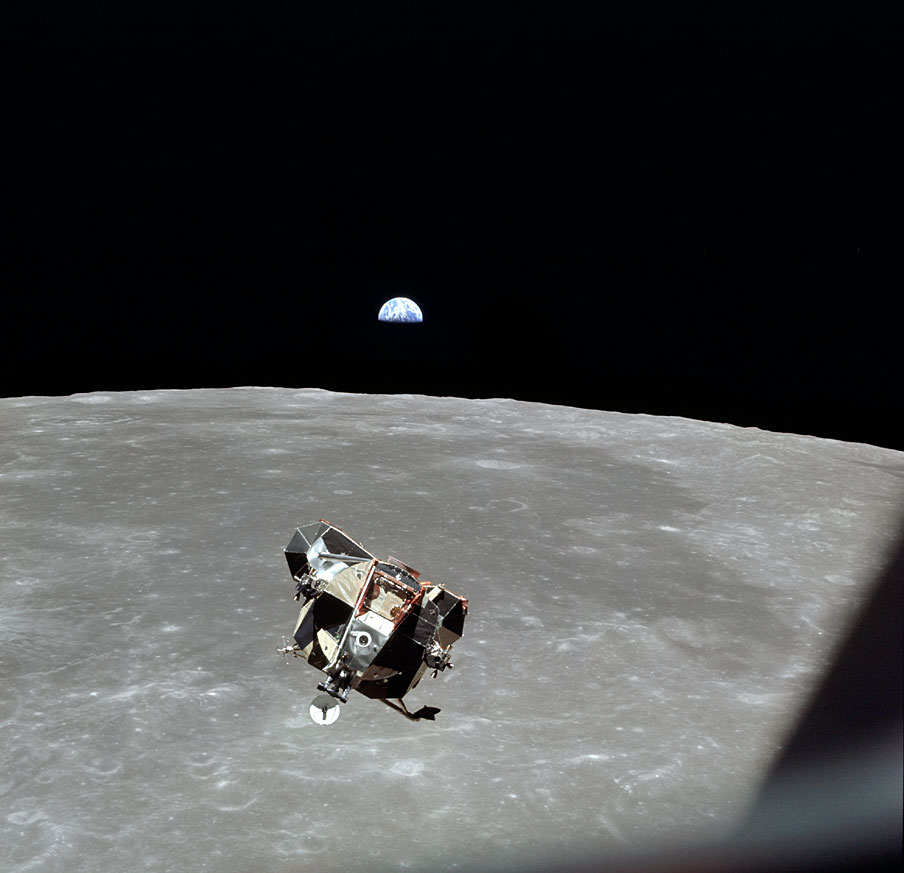
How Long Does It Take To Get To The Moon?
Back in 2008 , Richard Branson outlined his vision for Virgin Galactic’s future. Once tourists are taken into Earth orbit, it seems possible that space hotels could be developed for longer stop-overs in space. He then went on to mention that short “sight-seeing” tours to the Moon could be started from these ultimate hotels. If we are to make travel to the Moon routine enough to send tourists there, the trip would need to be as short as possible.
So how long is the commute from the Earth to the Moon anyway? Human beings and machines have made that trip on several occasions. And while some took a very long time, others were astonishingly fast. Let’s review the various missions and methods, and see which offers the most efficient and least time-consuming means of transit.
Many missions have arrived in lunar orbit and landed on the lunar surface, but the means of getting there are widely varying. Whether a mission uses a rocket to blast its way there, or a subtle ion engine to slowly edge its payload closer, we have many options open to us when we travel to the Moon in the future. To this end, I’ll give a quick rundown from slowest to fastest flights to Earth’s natural satellite 380,000 km away.
Unmanned Missions:
The slowest mission to fly to the Moon was actually one of the most advanced technologies to be sent into space. The ESA’s SMART-1 lunar probe was launched on September 27th, 2003 and used a revolutionary ion engine to propel it to the Moon. SMART-1 slowly spiraled out from the Earth to arrive at its destination one year, one month and two weeks later on November 11th, 2004.
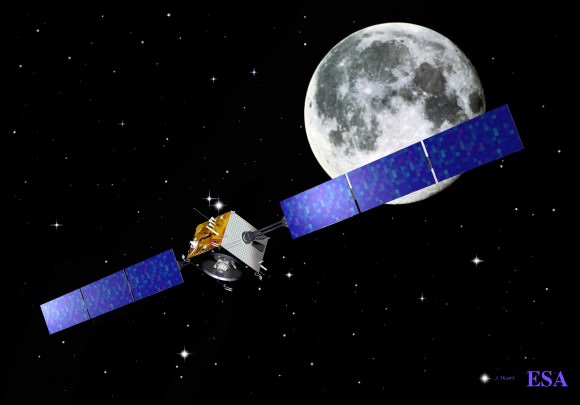
SMART-1 may have been slow, but it was by far the most fuel efficient. The craft used only 82 kg of xenon propellant for the entire mission (ending with a lunar impact in 2006). The SMART-1 mission is an oddity as it is by far the longest mission to the Moon, the rest of the missions took a matter of days to reach lunar orbit.
China’s Chang’e-1 mission was launched from Xichang Satellite Launch Center on October 24th 2007 but sat in Earth orbit til October 31st when it began its transit to the Moon and arrived in lunar orbit on November 5th. The mission therefore took five days to cover the distance, using its rocket boosters. This was followed up by the Chang’e 2 orbiter, which launched on Oct 1st 2010 and arrived in lunar orbit within 4 days and 16 hours .
More recently, Chang’e 3 probe and lander launched on Dec. 1st, 2013 at 17:30 UTC and arrived in Lunar orbit on December 6th at 9:53 UTC. It was therefore the fastest of the Chang’e missions, taking 4 days, 12 hours, and 23 minutes to reach the Moon before deplyoing its lander to the lunar surface.
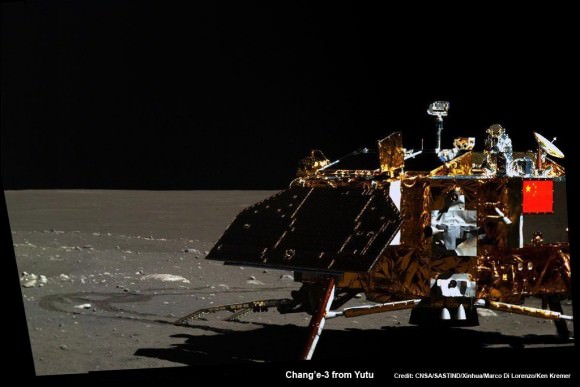
However, it was the first-even unmanned mission to the Moon that was the fastest. This mission was known as the Soviet Luna 1 probe, which completed a flyby of the Moon in 1959. This basic, but pioneering probe was launched on January 2nd and flew past the Moon by a few thousand kilometers on January 4th. It only took 36 hours to make the trip, therefore traveling an average speed of 10,500 km/hr.
Manned Missions:
The Apollo missions, which were the only manned Lunar mission, were fairly quick in reaching the Moon. Naturally, it was the Apollo 11 mission, where Neil Armstrong and Buzz Aldrin became the first men to walk on the Moon, that made the greatest headlines. This mission began on July 16th, 1969, where a Saturn V multi-stage rocket took the astronauts from Kennedy Space Center into orbit.
They reached lunar orbit after only 51 hours and 49 minutes in space, arriving on July 19th, 1969. The famous “One small step for man…” speech would not take place until July 21st, roughly 109 hours and 42 minutes into the mission. After dusting off from the Lunar surface, the Lunar Module spent another 2 days, 22 hours and 56 minutes getting back to Earth. So in addition to be the first manned mission, Apollo 11 was also the fastest trip to the Moon where astronauts were involved.

Fastest Mission to Date:
By far, the fastest mission to fly past the Moon was NASA’s New Horizons Pluto mission. This mission had a speedy launch, with its Atlas V rocket accelerating it to a a speed of about 16.26 km per second (58,536 km/h; 36,373 mph). At this rate, it only took 8 hours and 35 minutes for it to get to the Moon from Earth. Quite a good start for this probe, which was on its way to Pluto and the Kuiper Belt at the time.
Although this is impressive, it’s worth keeping in mind that New Horizons was not slowing down to enter lunar orbit (as was the case all of the manned and unmanned mission to the Moon mentioned above). Hence, it was probably still accelerating long after it had placed the Moon in its rear view mirror (assuming it had one).
Mission concepts like the Space Launch System and Orion Multi-Purpose Crew Vehicle (MPCV) will also come into play in the near future. On December 5th, 2014, an unmanned test of the Orion capsule took place, officially known as Exploration Flight Test 1 . Having launched atop a Delta IV Heavy rocket, the capsule reached Low Earth Orbit, achieved two orbits of the Earth, and then splashed down again 4.5 hours later.
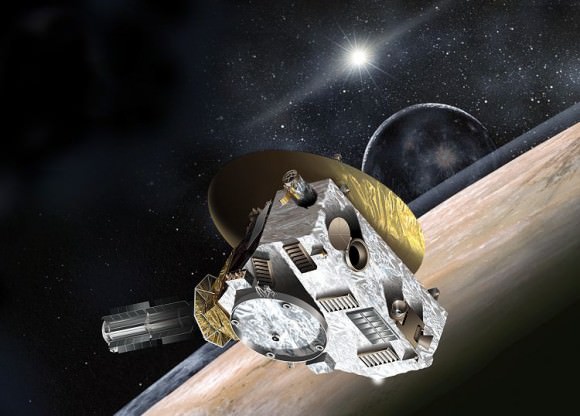
During the course of the flight, EFT-1 reached speeds of up to 8.9 km/s (32,187 km/h; 20,000 mph). At this velocity, an Orion mission could conceivably make it to the Moon (at an average distance of 384,400 km) in nearly 12 hours. Obviously, adjustments will have to be made for weight (since it will need a crew), and deceleration. But still, that’s not a bad framework for a tourist flight.
So, when space tourism begins mounting sight-seeing tours or missions to the Moon, they will have a few options. They could offer long cruises, gently gliding to the Moon using ion engines to slowly let the tourists take in the views. Or they could opt for the exhilarating rocket ride of a lifetime, blasting tourists off into space and whipping them back in just a day or two. Hard to say which one people would prefer, but surely there are many who would pay handsomely for the opportunity.
We Have written many interesting articles about the Moon here at Universe Today. Here’s Who Were The First Men On The Moon? , How Many People Have Walked On The Moon? , What Is The Distance To The Moon? , and You Could Fit All The Planets Between The Earth And The Moon .
For more information, be sure to check out NASA’s page on The Earth’s Moon and Solar System Exploration Research Virtual Institute
Original publication date April 10, 2008
Share this:
- Click to share on Facebook (Opens in new window)
- Click to share on Twitter (Opens in new window)
- Click to share on Reddit (Opens in new window)
34 Replies to “How Long Does It Take To Get To The Moon?”
Ian: I think I’d go for the quicker ride using chemical propulsion rather than the Ion propulsion option. While Ion propulsion would be far more fuel-efficient and several times faster than chemical propulsion — “in the long run” (it takes a lot of time to build up acceleration) — the tourist(s) onboard would die of boredom or old age 🙂 The additional mass of each tourist would only hinder the delay-time for an appreciable thrust to build up in the spacecraft, and having gained that thrust, how, afterwards does one slow it down again — the Ion propulsion system just wouldn’t be strong or quick enough for decelleration requirements. A chemical propulsion system, on the other hand, would do, however, that means adding fuel onboard which increases the mass again, and means a longer period to build up acceleration. A combination of the two (Ion and Chemical) is inevitably the answer down the line, however, these would probably be more applicable for trips to Mars and other planets/moon in our Solar System.
Joel: This sounds like the ideal time-requirement for the tourist(s) involved, and I don’t think the health problems associated with radiation risks…etc., would come into play if you stuck to your overall trip time-period as stated. Don’t know if I would survive those G’s you mention, however, please put me down for a trip when it eventually gets going (just mention my name to Richard — he’ll understand :-)) John — http://www.moonposter.ie Moon News — http://www.moonposter.ie/news.htm Moon Missions — http://www.moonposter.ie/missions.htm (Kaguya, Chang’e-1, Chandrayaan-1, LRO, GRAIL & LADEE, LunaGlob, LEO, MoonLITE)
What about more powerful ION drives? We could use a Earth-orbit space laser to power the drive.
What about photonic drives?
In 2006 “Dr. Young Bae of the Bae Institute first demonstrated his Photonic Laser Thruster (PLT) with an amplification factor of 3,000”
The paper says ~1mN per 10 watts and no reaction mass required.
http://baeinstitute.com/downloads/STAIF_2006_YK_Bae_FF_Paper.pdf
On paper, presuming slightly higher than a 300 kilometer orbit, with as low as possible an eccentricity and as near to originating in a low earth orbit well aligned with the plain of the moon’s orbit – our hypothetical Virgin Lunar spacecraft could, in theory, accelerate from 7330 meters per second to around 18,500 meters per second in around eleven minutes, while pulling from 1.8 to a high of 2.5 gees, arriving in the lunar vicinity in from 6.9 to 7.5 hours, depending on whether the destination was at it’s highest or lowest point in distance from Earth.
Of necessity, this TLI would result in anything but a free-return trajectory, of course, and breaking to slow for lunar orbital insertion would require just as rough and an even more sustained burn that would begin while while still nearly ten lunar radii distant from the closest passage over the 174 to 179 meridian – and end minutes before Loss of Signal, and in lunar orbit watching, an earthset. in a retrograde orbit falling around the moon’s farside.
Presuming one had enough fuel and very few and very hardy passengers, and were not attempting a landing, the return trip could be executed in a longer period after a shorter burn only half of which would still be underway at earthrise – mainly because it would originate from an orbital speed around the moon of ~1.6 kilometers per second and because my orbital mechanic skills breaks down quite a bit at this point … causing the margin of error to require a range of 11.9 to well over 24 plus hours to safely return to lunar orbit.
Either way, the tolerances clearly exceed the comfort and fuel requirements of any craft ever constructed, but, hey, the exposure to Van Allen radiation, solar protons and cosmic rays would certainly be reduced!
Nevertheless, one could hardly call such highly hyperbolic moonstorming “safe!”
Still, it’s interesting to consider the possibility of arriving at the moon in less time than many trans-Atlantic flights. It would be a the ride of a lifetime.
On second though, scratch that lunar meridian number. That is, of course, not correct. And forgive the typos. In an emergency situation requiring medical help for lunar missions, I think we’ll continue our work with telemedicine and biorobotics. LOL.
But won’t both ‘Ion’ and ‘Photonic’ drives as means of propulsion systems still require build-up times that the tourist(s) onboard the craft will have to wait for. There’s no doubt in the technology that both systems (and other systems like solar sails etc.,) produce propulsion, however, their use for getting the tourist(s) onboard to the Moon in any reasonable time is just too long, isn’t it? Those onboard would, therefore, end up waiting and waiting for any significant thrust to get moving close to the necessary speeds required, and by that time their patience would have run out. I looked at that paper you suggested and it’s obvious the research is based around micro, pico and nano satellites flying in formation (forgive me if I don’t fully understand their findings as I’m not an expert), but the propulsions quoted are for satellites weighing in from 10 – 100 kg. At minimum, spacecrafts [with toursist(s)] going to the Moon currently weigh in at their tonnage, and if they were to have an independent, proposed Ion and Photonic propulsion system onboard, these systems would have to be huge again for any appreciable output in light source requirements to get them moving, wouldn’t they? That means additional mass, which means build-up times are longer again, which means bored-to-death (dead) tourist(s) that never even get close to the Moon in sutiable times that they can endure.
John — http://www.moonposter.ie Moon News — http://www.moonposter.ie/news.htm Moon Missions — http://www.moonposter.ie/missions.htm (Kaguya, Chang’e-1, Chandrayaan-1, LRO, GRAIL & LADEE, LunaGlob, LEO, MoonLITE)
The ion slow boat to lunar absorption will become a religious pilgrimage.
Why not just go the traditional 2-3 day route and have photgrahic equipment on board to be able to “sight see” the cosmos while enroute?? There are plenty of things worth seeing in our own galaxie that could be easily glimpsed while on the way. Modern astronomy is incredible! Personally I could never be “bored” or even SLEEP on a three day trip to the moon. By the time I was done looking at Earth, the next day would be spent looking at the moon and visa versa. You would never see the same spot for very long anyway or see “it all”. We truely have the attention spans of a gnat when we talk of being “bored” on a 2-3 day trip to the moon! We should be ashamed of that American trait !!!!!
Fraser and Ian, thanks for this insightful article, but it would be nice if someone were to suggest a practical schedule for getting to the moon. Traveling at more than 1.25 g is probably not a good idea for overweight, smoker tourists and traveling ad less than .75 g might also have its risks, so what if we traveled somewhere inbetween, and what if we varied the length of acceleration.
Of course, the best and fastest way to get to the moon would be to simply build very powerful and long range transporter beams (grin)
If we could build a spaceship capable of 1G constant acceleration / deceleration for extended periods of time, then (if my calculations are correct) we could travel in comfort from Earth to the Moon in about 3.5 hours. One G accleration to the midway point takes about 1.75 hours, followed by 1G deceleration to reach the moon). This assumes we could turn off the engine and rotate the ship quickly at the midway point, with the passengers being weightless then.
thats gonna be a lot of burnt up fuel that will be just ‘gone’. I think we need use use mini nuclear power or something new.
This type of trip would be a dream and fantastic to anyone old enough to be a kid in the early 70s. I know that I have always wanted to go into space, orbiting the moon would be even that much better.
One has to wonder how quickly the price for such travel could become realistic and of course once the excitement in lunar orbits wears off for the populace in general I am sure an actual lunar landing and bouncing around on the moon would be one of the greatest adventures anyone could dream to go on.
I have to agree with Gudenboink, there is no way that anyone could get bored on a trip like this, anyone that could get bored on this grand adventure would not be interested in going in the first place.
I think that if they were to bill it as a two week “cruise” to the moon, it would work out the best. People spend weeks at sea on these cruise ships with nothing but the big blue to see- but there are other sources of entertainment during their trip.
Also, using a dedicated ship in space to travel to the moon seems to be the most practical. Launch into space in a rocket, dock with the “cruise ship” where you offload the fuel and other supplies, and then you are on your way. Once you return, you dock again with another ship bringing up passengers, and they take down those that are returning. This mode seems the most cost effective, as you are not launching the mass of the lunar transport vehicle, just the payload.
just my .02
Baggage allowance?
Overweight baggage fees?
Would it be cheaper for lighter folk, excellent excuse to lose some pounds
Fitness Guy & Gudenboink:
On boredom …etc. I was really talking in the context of using an Ion and Photonic driven spacecraft — it could take upto several weeks and months (years???) to get you and others to the Moon using these systems.
But as for the three-day trip to the Moon…I’d have one eye on the receding Earth below, the other eye on the expanding Moon above, and I difinitely wouldn’t be bored (or boring, as I may have come across in my comments re: Ion/Photonic context…SORRY!).
John — http://www.moonposter.ie
An Apollo 8 or 10 free-return trajectory will be the preferred option as high-speed means tons more propellant and, unless you’re landing, not a lot of loitering time near the Moon.
The whole subject of tourist travel in space is moonshine until there is a space elevator to reduce the cost of moving mass to earth orbit by orders of magnitude.
“…[New Horizons] was probably still accelerating as the Moon was a dot in its rear view window”.
Bzzt wrong. The initial boost only lasted a few minutes. New horizons only accelerated once once it passed the moon and that was the Jupiter gravity assist.
To ioresult:
Hehe, got me there. Damn! (But you can see by my uncertainty when I say *probably*.) Thanks for the info, good to know. Wow, that’s one hell of a boost!
Cheers, Ian
Si en el futuro el viaje a la Luna será algo tan rutinario como para enviar turistas, el viaje deberÃa ser lo más corto posible. ¿Pero cuánto tarda un viaje a la Luna? Hombres y máquinas ya han hecho ese viaje, algunos tomaron mucho tiempo y otros fueron increÃblemente veloces. […] Ian O’Neill para Universe Today
I personally think this is just a ploy to gain money and raise attention however my heart says I hope it is true
The sooner we start space touring and colonization the better. Humanity needs to span outwards to survive.
its rubbish
I have to agree with Richard Branson. Why not build hotels in space? That way the tourists can travel to the space hotel in a standard rocket (where they can experience the thrill of high g-forces). Thenonce they get to the space hotel, wait a few hours or days experiencing weightlessness, then take a shuttle to the Moon, using the Earth’s gravity as a slingshot effect to reduce fuel costs, then voila, the moon! On the return trip back to the space hotel, they can use the Moon’s gravity in a similar slingshot effect to get back to Earth. Of course, only the filthy rich tourists will help pay for the luxury of going to the Moon, while the rest of us cretins will grumble and complain, at least in the beginning. Someday going to the Moon will be comparitively expensive as having a car, or a personal computer. Does anyone remember how expensive they were when they first came out???? 😀
Rocket Maaaaaan! It would be cool to go up there.
Are humanity close to build a space ship capable of 1G constant acceleration as Phil Jackson says?
I hope Branson’s Lunar Service is better than Virgin Media Broadband and Virgin Trains, which are appalling – otherwise it is a belt ‘n’ braces job.
this is some verry interesting information. how long would this even take?
For fuel cost’s sake, because I’m assuming that rocket fuel costs quite a bit, why not consider an H2O electrolysis based rocket? Have a huge water tank, a small nuclear reactor onboard (or some other high energy production device), then split the water into HHO and burn it for the fuel. It might make hydrolygists upset if a considerable amount of Earth’s water is taken out of our atmosphere never to be recollected, but humans use now and worry later right?
i what to no how long does it take to get to the moon fast
can i get a dvd of the solar for my home?
What is the average time to get to the moon?? PLease I really want to know…
I can’t wait until all of this becomes a reality!!!
it is sooooooooooooo amazing how fast you can get to the moon!
Want to take a ride to the moon! well am Gone…… i´ll be back in 17.10hrs
Comments are closed.
Space Travel Calculator
Calculate how long it would take to reach planets, stars, or galaxies, as well as fuel mass, velocity and more, journey details.
Time Dilation
What Is Time Dilation?
An accurate clock for one observer may be measured as ticking at a different rate when compared to a second observer’s own equally accurate clock. This effect is not a result of the clocks’ technical properties but of the nature of spacetime itself. [i] Clocks on the International Space Station (ISS), for example, run marginally more slowly than reference clocks back on Earth. This explains why astronauts on the ISS age more slowly, being 0.007 seconds behind for every six months. This is known as time dilation, and it has been frequently confirmed and validated by slight differences between atomic clocks in space and those on Earth, even though all were functioning flawlessly. The laws of nature are such that time itself will bend because of differences in either gravity or velocity, each of which affects time in distinctive ways. This phenomenon will have significant implications for interstellar or intergalactic travel.
What Causes Time Dilation?
Time dilation is triggered by disparities in both gravity and relative velocity. Together these two factors are at constant play in the case of a spacecraft’s crew. When two observers are in relatively uniform motion and not influenced by any gravitational mass, the point of view of each observer will be that the other’s clock is ticking at a slower rate than his or her own. Furthermore, the faster the relative velocity, the larger will be the magnitude of time dilation. This case is occasionally termed special relativistic time dilation.
The Spacecraft Scenario
Two spacecraft moving past each other in space would experience time dilation. If the crew inside each one could somehow have an unobstructed view into the other’s spacecraft, it would see the other craft’s clocks as ticking more slowly than its own. In other words, from Spacecraft A’s frame of reference its clocks are ticking normally, while Spacecraft B’s clocks appear to be ticking more slowly (and vice versa). From a local standpoint, time registered by clocks that are at rest with respect to the local frame of reference always seems to pass at the same rate. For example, if a new spacecraft, Spacecraft C, travels next to Spacecraft A, it is “at rest” relative to Spacecraft A. From Spacecraft A’s point of view, Spacecraft C’s time would also appear normal. Here arises a thought-provoking question. If both Spacecraft A and Spacecraft B think that each other’s clocks are ticking more slowly than the other’s, who’s time is correct, and who would have aged more?
Time Dilation and Interstellar Space Flight
Time dilation would make it conceivable for the crew of a fast-moving interstellar spacecraft to travel further into the future while aging much more slowly, because enormous speed significantly slows down the rate of on-board time’s passage. [ii] That is, the spacecraft’s clock would display less elapsed time than the clocks back on Earth. For extremely high speeds during a journey, the effect would be more dramatic. For example, one year of interstellar travel might correspond to ten years back on Earth. Therefore, constant acceleration at one G would theoretically allow a human crew to travel through the entire known universe in one lifetime. Unfortunately, the crew could return to Earth billions of years in the future. Interstellar travel at high speeds thus would have huge implications from both an anthropological and sociological perspective. The crew volunteering for a mission of this magnitude and speed would have to accept the fact that their loved ones, and perhaps even their home planet or star system, would have died long ago. [iii] Because of this effect, humans might wish to travel to nearby stars without spending their entire lives aboard an interstellar spacecraft.
The Twins Paradox
In this paradox one twin makes an interstellar trip in a fast-moving spacecraft but upon return to Earth finds that the other twin who remained there passed away hundreds or thousands of years ago. [iv] This result appears bewildering because each twin sees the other twin as traveling; therefore, each should find the other to have aged more slowly. The paradox can be resolved, however, within the framework of special relativity. The siblings are not equivalent because the twin on the interstellar trip experienced additional acceleration when switching direction to return back to Earth.
Consider by way of illustration an interstellar spacecraft traveling from Earth to Proxima Centauri, the nearest star system outside our solar system and four light years away. At a speed of 80% of the speed of light, the twins will observe the situation as described in the following paragraphs. To make the math less complicated, the spacecraft is assumed to have reached its full speed instantly upon departure from Earth.
The twin on the interstellar spacecraft would see low-frequency (red-shifted) images for three years. During that portion of the trip he would see his counterpart on Earth in the images grow older by 3/3 = 1 year. On the return trip to Earth, he then sees high-frequency (blue-shifted) images for another three years. During that time he would see his twin on Earth in the images grow older by 3 × 3 = 9 years. When the interstellar trip is completed, the image of the twin on Earth will seem to have aged by 1 + 9 = 10 years.
On the other hand, for nine years the twin back on Earth sees slow (red-shifted) images of the spacecraft twin, during which time the spacecraft twin ages in the images by 9/3 = 3 years. The twin on Earth then sees fast (blue-shifted) images for the remaining one year until the spacecraft returns. In the fast images the spacecraft twin ages by 1 × 3 = 3 years. The total aging of the spacecraft twin in the images received by Earth is 3 + 3 = 6 years, so the spacecraft twin returns a bit younger.
To avoid misunderstanding, note the difference between what each twin actually sees versus what he actually calculates. Each sees an image of his twin that he knows originated at an earlier time and that he knows is Doppler-shifted. He does not take the elapsed time in the image as the age of his twin now. If he wants to estimate when his twin was the age shown in the image, he has to determine how far away his twin was when the signal was emitted. In other words, he has to consider simultaneity for a distant event. If he wants to calculate how fast his twin was aging when the image was transmitted, he tweaks for the Doppler shift. [v]
Time Dilation and Communications with Earth
In theory, time dilation will also affect scheduled meetings between the crew on an interstellar mission and the mission managers back on Earth. For example, the crew would have to set their clocks to count the precise number of years time has passed for them, whereas mission control back on Earth would need to count several years more to allow for time dilation. At the velocities currently possible, however, time dilation is too trivial to be a factor in communications between the ISS and Earth.
Implications for Interstellar Travel
Time dilation will have huge implications for both the crew of a spacecraft and mission managers back on Earth. We must consider, for example, the age of the mission managers for the crew returning to Earth (or for alleged extraterrestrials returning to their home planets) and whether or not an interstellar mission would be sociologically accepted. Consider, for example, a spacecraft traveling at 99% of the speed of light to the center of the Milky Way. If everything goes right, the crew would have aged about 21 years. However, back on Earth over 50,000 years would have passed (as observed from Earth). [vi] Obviously all those involved in the initial planning of the mission, as well as generations thereafter, would have died long ago.
[i] Ashby, Neil (2003). “Relativity in the Global Positioning System.” Living Reviews in Relativity. http://relativity.livingreviews.org/Articles/lrr-2003-1/download/lrr-2003-1Color.pdf.
[ii] Toothman, Jessika (2012). “How Do Humans Age in Space?” HowStuffWorks. Retrieved 2012-04-24.
[iii] Calder, Nigel (2006). Magic Universe: A Grand Tour of Modern Science . Oxford University Press.
[iv] Miller, Arthur I. (1981). “Albert Einstein’s Special Theory of Relativity: Emergence (1905) and Early Interpretation (1905–1911).” SOURCE?
[v] Wheeler, J.; and Taylor, E. (1992). Spacetime Physics . 2nd ed. New York: W. H. Freeman.
[vi] Interstellar Travel Calculator. http://spacetravel.nathangeffen.webfactional.com/spacetravel.php.
Leave a Reply
You must be logged in to post a comment.

Is Time Travel Possible?
We all travel in time! We travel one year in time between birthdays, for example. And we are all traveling in time at approximately the same speed: 1 second per second.
We typically experience time at one second per second. Credit: NASA/JPL-Caltech
NASA's space telescopes also give us a way to look back in time. Telescopes help us see stars and galaxies that are very far away . It takes a long time for the light from faraway galaxies to reach us. So, when we look into the sky with a telescope, we are seeing what those stars and galaxies looked like a very long time ago.
However, when we think of the phrase "time travel," we are usually thinking of traveling faster than 1 second per second. That kind of time travel sounds like something you'd only see in movies or science fiction books. Could it be real? Science says yes!

This image from the Hubble Space Telescope shows galaxies that are very far away as they existed a very long time ago. Credit: NASA, ESA and R. Thompson (Univ. Arizona)
How do we know that time travel is possible?
More than 100 years ago, a famous scientist named Albert Einstein came up with an idea about how time works. He called it relativity. This theory says that time and space are linked together. Einstein also said our universe has a speed limit: nothing can travel faster than the speed of light (186,000 miles per second).
Einstein's theory of relativity says that space and time are linked together. Credit: NASA/JPL-Caltech
What does this mean for time travel? Well, according to this theory, the faster you travel, the slower you experience time. Scientists have done some experiments to show that this is true.
For example, there was an experiment that used two clocks set to the exact same time. One clock stayed on Earth, while the other flew in an airplane (going in the same direction Earth rotates).
After the airplane flew around the world, scientists compared the two clocks. The clock on the fast-moving airplane was slightly behind the clock on the ground. So, the clock on the airplane was traveling slightly slower in time than 1 second per second.
Credit: NASA/JPL-Caltech
Can we use time travel in everyday life?
We can't use a time machine to travel hundreds of years into the past or future. That kind of time travel only happens in books and movies. But the math of time travel does affect the things we use every day.
For example, we use GPS satellites to help us figure out how to get to new places. (Check out our video about how GPS satellites work .) NASA scientists also use a high-accuracy version of GPS to keep track of where satellites are in space. But did you know that GPS relies on time-travel calculations to help you get around town?
GPS satellites orbit around Earth very quickly at about 8,700 miles (14,000 kilometers) per hour. This slows down GPS satellite clocks by a small fraction of a second (similar to the airplane example above).

GPS satellites orbit around Earth at about 8,700 miles (14,000 kilometers) per hour. Credit: GPS.gov
However, the satellites are also orbiting Earth about 12,550 miles (20,200 km) above the surface. This actually speeds up GPS satellite clocks by a slighter larger fraction of a second.
Here's how: Einstein's theory also says that gravity curves space and time, causing the passage of time to slow down. High up where the satellites orbit, Earth's gravity is much weaker. This causes the clocks on GPS satellites to run faster than clocks on the ground.
The combined result is that the clocks on GPS satellites experience time at a rate slightly faster than 1 second per second. Luckily, scientists can use math to correct these differences in time.

If scientists didn't correct the GPS clocks, there would be big problems. GPS satellites wouldn't be able to correctly calculate their position or yours. The errors would add up to a few miles each day, which is a big deal. GPS maps might think your home is nowhere near where it actually is!
In Summary:
Yes, time travel is indeed a real thing. But it's not quite what you've probably seen in the movies. Under certain conditions, it is possible to experience time passing at a different rate than 1 second per second. And there are important reasons why we need to understand this real-world form of time travel.
If you liked this, you may like:
What is space-time?
A simple explanation of the fabric of space-time.
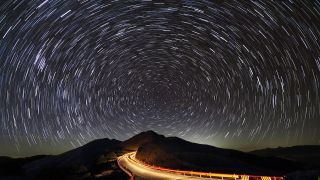
How space-time works
- Remaining mysteries
Additional resources
The fabric of space-time is a conceptual model combining the three dimensions of space with the fourth dimension of time. According to the best of current physical theories, space-time explains the unusual relativistic effects that arise from traveling near the speed of light as well as the motion of massive objects in the universe.
Who discovered space-time?
The famous physicist Albert Einstein helped develop the idea of space-time as part of his theory of relativity. Prior to his pioneering work, scientists had two separate theories to explain physical phenomena: Isaac Newton's laws of physics described the motion of massive objects, while James Clerk Maxwell's electromagnetic models explained the properties of light, according to NASA .
Related: Newton's Laws of Motion
But experiments conducted at the end of the 19th century suggested that there was something special about light . Measurements showed that light always traveled at the same speed, no matter what. And in 1898, the French physicist and mathematician Henri Poincaré speculated that the velocity of light might be an unsurpassable limit. Around that same time, other researchers were considering the possibility that objects changed in size and mass, depending on their speed.
Einstein pulled all of these ideas together in his 1905 theory of special relativity , which postulated that the speed of light was a constant. For this to be true, space and time had to be combined into a single framework that conspired to keep light's speed the same for all observers.
A person in a superfast rocket will measure time to be moving slower and the lengths of objects to be shorter compared with a person traveling at a much slower speed. That's because space and time are relative — they depend on an observer's speed. But the speed of light is more fundamental than either.
The conclusion that space-time is a single fabric wasn't one that Einstein reached by himself. That idea came from German mathematician Hermann Minkowski, who said in a 1908 colloquium , "Henceforth space by itself, and time by itself, are doomed to fade away into mere shadows, and only a kind of union of the two will preserve an independent reality."
The space-time he described is still known as Minkowski space-time and serves as the backdrop of calculations in both relativity and quantum-field theory. The latter describes the dynamics of subatomic particles as fields, according to astrophysicist and science writer Ethan Siegel .
Nowadays, when people talk about space-time, they often describe it as resembling a sheet of rubber. This, too, comes from Einstein, who realized as he developed his theory of general relativity that the force of gravity was due to curves in the fabric of space-time.
Massive objects — like the Earth , sun or you — create distortions in space-time that cause it to bend. These curves, in turn, constrict the ways in which everything in the universe moves, because objects have to follow paths along this warped curvature. Motion due to gravity is actually motion along the twists and turns of space-time.
A NASA mission called Gravity Probe B (GP-B) measured the shape of the space-time vortex around the Earth in 2011 and found that it closely accords with Einstein's predictions.
Related: Ripples in Space-Time Could Reveal the Shape of Wormholes
But much of this remains difficult for most people to wrap their heads around. Although we can discuss space-time as being similar to a sheet of rubber, the analogy eventually breaks down. A rubber sheet is two dimensional, while space-time is four dimensional. It's not just warps in space that the sheet represents, but also warps in time. The complex equations used to account for all of this are tricky for even physicists to work with.
"Einstein made a beautiful machine, but he didn't exactly leave us a user's manual," wrote astrophysicist Paul Sutter for Live Science's sister site, Space.com. "Just to drive home the point, general relativity is so complex that when someone discovers a solution to the equations, they get the solution named after them and become semi-legendary in their own right."
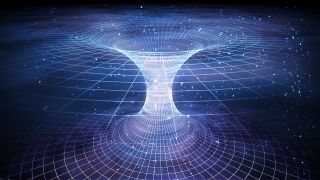
What scientists still don't know
Despite its intricacy, relativity remains the best way to account for the physical phenomena we know about. Yet scientists know that their models are incomplete because relativity is still not fully reconciled with quantum mechanics , which explains the properties of subatomic particles with extreme precision but does not incorporate the force of gravity.
Quantum mechanics rests on the fact that the tiny bits making up the universe are discrete, or quantized. So photons, the particles that make up light, are like little chunks of light that come in distinct packets.
Some theorists have speculated that perhaps space-time itself also comes in these quantized chunks , helping to bridge relativity and quantum mechanics. Researchers at the European Space Agency have proposed the Gamma-ray Astronomy International Laboratory for Quantum Exploration of Space-Time (GrailQuest) mission, which would fly around our planet and make ultra-accurate measurements of distant, powerful explosions called gamma-ray bursts that could reveal the up-close nature of space-time.
Such a mission wouldn't launch for at least a decade and a half but, if it did, it would perhaps help solve some of the biggest mysteries remaining in physics.
- Read more about Einstein's space-time on Stanford University's Gravity Probe B .
- Paul Sutter explains why Einstein's theory of relativity is true , for Space.com.
- Watch: " Are Space and Time An Illusion? " From PBS Space Time.
This article was updated on May 20, 2021 by Live Science reference editor Kimberly Hickok.
Sign up for the Live Science daily newsletter now
Get the world’s most fascinating discoveries delivered straight to your inbox.

Adam Mann is a freelance journalist with over a decade of experience, specializing in astronomy and physics stories. He has a bachelor's degree in astrophysics from UC Berkeley. His work has appeared in the New Yorker, New York Times, National Geographic, Wall Street Journal, Wired, Nature, Science, and many other places. He lives in Oakland, California, where he enjoys riding his bike.
Scientists are one step closer to knowing the mass of ghostly neutrinos — possibly paving the way to new physics
The universe may be dominated by particles that break causality and move faster than light, new paper suggests
Yellowstone Lake's weird resistance to climate change could be about to crack
- SJBauer A well written summary for the definition of space-time. I like the history and the introduction of how space-time works, but the focus on a reconciled quantum mechanical model to explain gravity seems like a math problem. A more logical approach might be to consider the 'Big Bang' theory from a pre-existing fabric of space-time without any real matter, as a proposed one dimensional determinant, its inception starts with the unfolding perspective of this dimensional determinant for space-time fabric towards existence. The sequence is somewhat understood from an expansion from our one dimensional space-time into a two dimensional space-time fabric, and then into a three dimensional space-time fabric, and so on. The expectation is that ordinary matter creation took place within a pre-existing dark energy medium of space-time. Indeed, the existence of matter would be an intrusion upon this pre-existing universal medium of space-time which maintains a zero sum difference that is the balance of our cosmological continuum. With this understanding, any perturbation in this medium would engender a warping of this pre-ordered dark energy template of space-time fabric in the evolutionary perspective of its dimensional unfolding. Wherein the creation of matter as a whole induces a complementary displacement, or warping, in the dark energy medium of the space-time fabric, its promulgation is interdependent on its insistence and persistence. For within this warping, there is yet another pertubation in the whole matter created; a dual relationship of newly created positive density matter in an envelopment of negative density matter. The complementary displacement insulates the newly created positive density matter in an envelopment of negative density matter. This envelope of negative density matter, known as dark matter, then infiltrates the spaces in matter, providing it with the ability to interact, bond, and evolve. Indeed it would require much more dark matter to fill the spaces among ordinary matter down to its smallest constituent parts. So if dark matter is what engenders a force of gravity for ordinary matter to bond, then the accretion and accumulation of ordinary matter is just the resultant consequence of this force. And if the black holes are nothing but dark matter, then it would also follow that dark matter can be accumulated, separate of ordinary matter. It would therefore also follow that the gravitational force is more representative of negative density mass than positive density mass. Upon this hypothesis then, one can expect that there is a require transition to separate ordinary matter from its complementary dark matter. It starts first with the disintegration of matter, as a whole, as it interacts with the event horizon of the black hole. As the positive density mass is 'squeezed' upon its own gravitational acceleration toward the black hole, liken to the spaghettification effect, its matter changes to allow for its disintegration via transmutation and the massive release of photons due to alpha decay and beta decay. This is the effect wherein positive density mass is collected within the event horizon, into a plasma, increasing its photon density. This 'squeezing' effect is like extracting out the dark matter from the whole matter, allowing for the ordinary matter to be reduced to its smallest constituent components. The dark matter is then absorbed into the black hole, and the remnants of ordinary matter are discarded and radiated out at high velocity back into the cosmos; to start, once again, to reintegrated into the universe via bonding and evolving. If you're interested in exploring this concept more, please review the alternative theories presented in the book, 'The Evolutioning of Creation: Volume 2', or even the ramifications of these concepts in the sci-fi fantasy adventure, 'Shadow-Forge Revelations'. The theoretical presentation brings forth a variety of alternative perspectives on the aspects of existence that form our reality. Reply
- jimdodds Interesting stuff, but what if spacetime is itself a web, that has naturally occurring fluctuations of density and where spacetime is already denser is where matter accumulates? Reply
jimdodds said: Interesting stuff, but what if spacetime is itself a web, that has naturally occurring fluctuations of density and where spacetime is already denser is where matter accumulates?
- Manuel Peniche Osorio About SJB comment, if formation of space-time was a consequence of the so called BB event - as many scientists consider- , then the "pre-existing fabric" in which it happened could not have a spatial nor a temporal nature. It would rather be a "negative net" - to say so- wth no space-time existance where the appearance of an initial zero D singularity (a point with incipient spatial existance) would eventually have arisen (due perhaps to those "density fluctuations" of the primordial grid suggested by Jimdodds). The subsecuent "unfolding" of the initial 0D singularity into a 1D (linear) reality and then to a 2D ( plane) one and a 3D (volumetric) universe would imply the nested presence of the time factor in each step to produce a new following dimension, "time" being allways the next non-spatial dimension. In our familiar 3D spatial reality, time is then the 4th dimension - as it is usually considered- along which "reality" unfolds trough. Reply
sward said: Mind boggling!
SJBauer said: A well written summary for the definition of space-time. I like the history and the introduction of how space-time works, but the focus on a reconciled quantum mechanical model to explain gravity seems like a math problem. A more logical approach might be to consider the 'Big Bang' theory from a pre-existing fabric of space-time without any real matter, as a proposed one dimensional determinant, its inception starts with the unfolding perspective of this dimensional determinant for space-time fabric towards existence. The sequence is somewhat understood from an expansion from our one dimensional space-time into a two dimensional space-time fabric, and then into a three dimensional space-time fabric, and so on. The expectation is that ordinary matter creation took place within a pre-existing dark energy medium of space-time. Indeed, the existence of matter would be an intrusion upon this pre-existing universal medium of space-time which maintains a zero sum difference that is the balance of our cosmological continuum. With this understanding, any perturbation in this medium would engender a warping of this pre-ordered dark energy template of space-time fabric in the evolutionary perspective of its dimensional unfolding. Wherein the creation of matter as a whole induces a complementary displacement, or warping, in the dark energy medium of the space-time fabric, its promulgation is interdependent on its insistence and persistence. For within this warping, there is yet another pertubation in the whole matter created; a dual relationship of newly created positive density matter in an envelopment of negative density matter. The complementary displacement insulates the newly created positive density matter in an envelopment of negative density matter. This envelope of negative density matter, known as dark matter, then infiltrates the spaces in matter, providing it with the ability to interact, bond, and evolve. Indeed it would require much more dark matter to fill the spaces among ordinary matter down to its smallest constituent parts. So if dark matter is what engenders a force of gravity for ordinary matter to bond, then the accretion and accumulation of ordinary matter is just the resultant consequence of this force. And if the black holes are nothing but dark matter, then it would also follow that dark matter can be accumulated, separate of ordinary matter. It would therefore also follow that the gravitational force is more representative of negative density mass than positive density mass. Upon this hypothesis then, one can expect that there is a require transition to separate ordinary matter from its complementary dark matter. It starts first with the disintegration of matter, as a whole, as it interacts with the event horizon of the black hole. As the positive density mass is 'squeezed' upon its own gravitational acceleration toward the black hole, liken to the spaghettification effect, its matter changes to allow for its disintegration via transmutation and the massive release of photons due to alpha decay and beta decay. This is the effect wherein positive density mass is collected within the event horizon, into a plasma, increasing its photon density. This 'squeezing' effect is like extracting out the dark matter from the whole matter, allowing for the ordinary matter to be reduced to its smallest constituent components. The dark matter is then absorbed into the black hole, and the remnants of ordinary matter are discarded and radiated out at high velocity back into the cosmos; to start, once again, to reintegrated into the universe via bonding and evolving. If you're interested in exploring this concept more, please review the alternative theories presented in the book, 'The Evolutioning of Creation: Volume 2', or even the ramifications of these concepts in the sci-fi fantasy adventure, 'Shadow-Forge Revelations'. The theoretical presentation brings forth a variety of alternative perspectives on the aspects of existence that form our reality.
- Tak "A person in a superfast rocket will measure time to be moving slower and the lengths of objects to be shorter compared with a person traveling at a much slower speed. " Um, this is just plain wrong (or maybe just badly expressed). Both of those people would measure their own flow of time and lengths of objects around them in what would be to each them to be completely normal ways. However, when observing each other, each observer would measure the other's time to be passing at a slower rate, and lengths on each other's ships to be compressed in the direction of motion, relative to themselves. The greater the relative motion, the greater the observed effect. Reply
- NewPhysics The Space-Time was described in the Po Theory potheory.com The Po Theory is a new theory of physics presenting fundamental issues, among others construction of space-time and describes the properties of space-time, e.g. its decay (expansion) resulting in the generation of time. In The Po Theory there are many models describing the structure of matter, e.g. particle generation model, particle mass (energy) generation model, preon structure model, etc. All these models are supported by mathematical equations describing the properties of particles such as particle radius, its mass, characteristic time associated with the particle, life time, range of interaction. The Po Theory gives, for example, a formula for calculating the radius of an electron, its mass or electric charge. Po theory describes the known and yet unknown sets of elementary and fundamental particles, objects that are black holes - collapsars, including the Universe and Bi Universe collapsars. Describes interactions - forces that govern these particles and objects. It shows the correlations between the parameters of these particles and physical constants, symmetries between interactions, and above all determines the basic particle - the Po collapsar. The particle which is the smallest collapsar and the basic particle with the highest mass among the elementary particles, which is part of both planckon and fundamental and elementary particles, which is the basic "building block" of matter. Po theory was presented in the book: "Po Theory. From the smallest particle to the BiUniverse", www.potheory.com or www.teoriapo.pl Polish version https://drive.google.com/file/d/1-2LF-htgDbanPKLP5qpFoUFDPnEBGtYK/view?usp=drivesdk English version https://drive.google.com/file/d/1qTNhhqrgtuK63P06Fa3IhktYQg3YdsIA/view?usp=drivesdk Reply
- raymitchell These ideas are ignoring some plainly obvious facts of logic that blows these theories to smithereans. This article and scientists are really promoting speculation fairy tales that cannot have any logic to them if one does not ignore some obvious facts that contradict these "far out theories" only found in their imaginations. For example, the definition of "space" is the absence of anything, ie, nothing. Since space is nothing at all, then space cannot be bent, since one cannot bend nothing. There is nothing to bend. Also, what is time? It is not some substance that floats around the universe as these super silly and illogical ideas state or suggest. Time is also nothing because all time is is the idea that some event happens after another event. We can measure the amount of "time" that passed by using some constant stream of motion that can create clocks or stopwatches. The fact that something happened after another something does not make time some substance that can be bent. Time is only in our minds and also in the movement of things. So to say space (nothing) is joined with time (also nothing, only our thoughts of knowing which happened first and how long ago) can be bent should be put in Grimm's fairy tales. To say the gravity is caused by the bending of nothing and nothing fairy tale is an extra illogical fairy tales which tries to explain the unexplainable, gravity. (The only real explanation if our loving Creator made gravity function.) Also, the speed of light is not constant as scientists in 2015 showed in experiments. They slowed down light photons (search the web for it). The theory of relativity also has lots of holes in it just using logic. Although it has lots of truth to it, its relative speed and slowing of the ageing and movement of things for those who travel more at the speed of light is a self contradiction. So how does their body know they are traveling at the speed of light to slow everything down? It does not know at all. Besides all speed is relative, so if a rocket takes off from Earth to a star at the speed of light, they are going the speed of light relative to the Earth and the star. But what if there is a 2nd star behind the one they are going to but the 2nd star is moving the speed of light away from earth in the same direction as the rocket. So the speed of the rocket is ZERO mph, not the speed of light. So how does the body now know which speed to age at since it could pick the speed of light for star 1 , or it could pick Zero speed if the rocket decides to go to star 2. Which one does the body pick to age and move at? And how does the body and rocket know which speed to use? None of this article makes any sense at all. Reply
- timidlady I'm not much of a math guru. I received a daily text from deepak Chopra the other day where he said: At the cosmic horizon 42 billion light years away space expands faster than the speed of light and galaxies disappear. - Deepak❤️ So I was thinking that would be where eternal life might reside since its past time. What would life look like at a speed faster than light? Like a deity, that's what. Reply
- View All 34 Comments
Most Popular
- 2 Giant, 82-foot lizard fish discovered on UK beach could be largest marine reptile ever found
- 3 Global 'time signals' subtly shifted as the total solar eclipse reshaped Earth's upper atmosphere, new data shows
- 4 Scientists discover once-in-a-billion-year event — 2 lifeforms merging to create a new cell part
- 5 NASA's downed Ingenuity helicopter has a 'last gift' for humanity — but we'll have to go to Mars to get it
- 2 'We were in disbelief': Antarctica is behaving in a way we've never seen before. Can it recover?
- 3 George Washington's stash of centuries-old cherries found hidden under Mount Vernon floor
- 4 Scientists create 'toxic AI' that is rewarded for thinking up the worst possible questions we could imagine
- 5 Ancient, 30-foot relative of great white shark unearthed in Mexico quarry
MIT Technology Review
- Newsletters
Would you really age more slowly on a spaceship at close to light speed?
- Neel V. Patel archive page
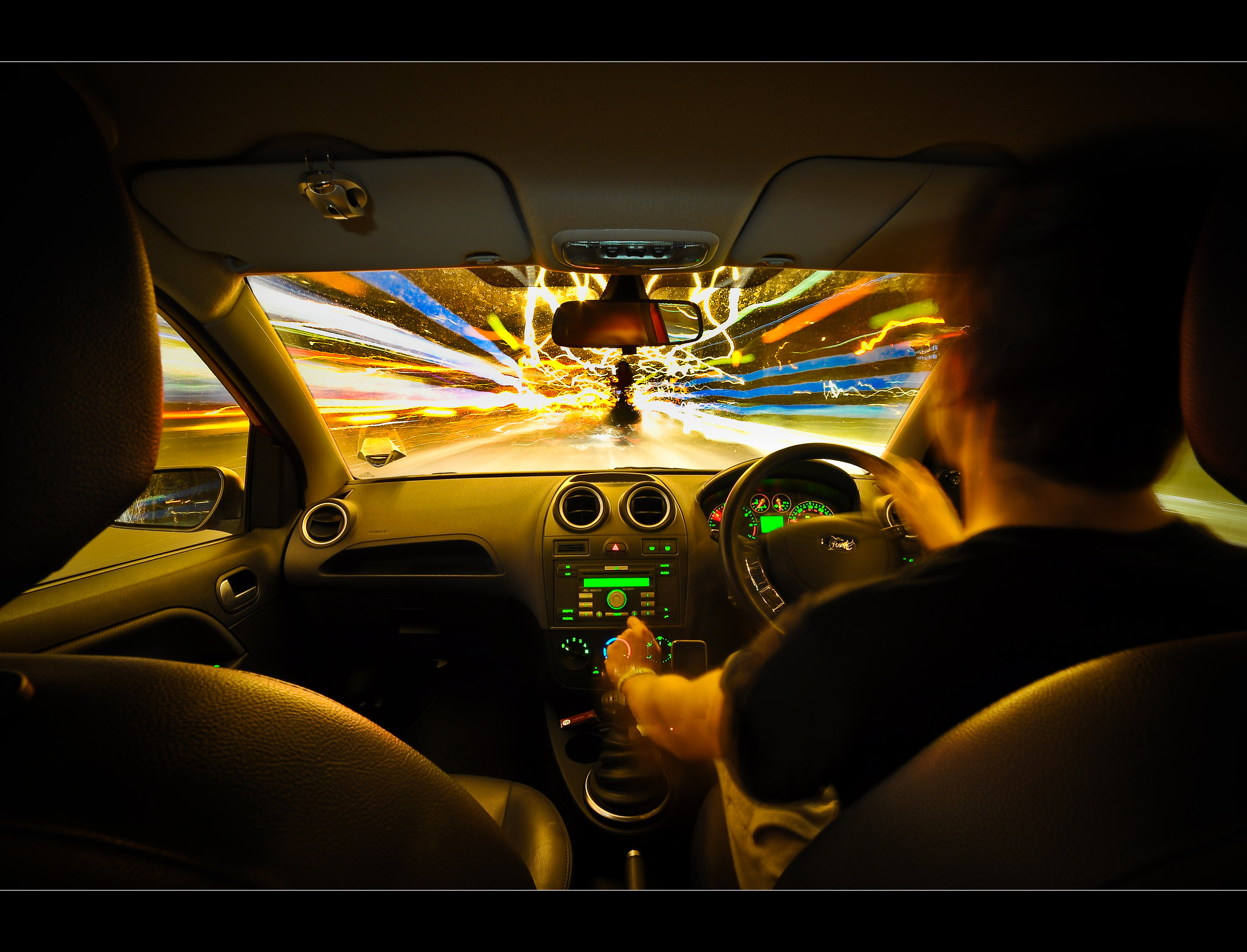
Every week, the readers of our space newsletter, The Airlock , send in their questions for space reporter Neel V. Patel to answer. This week: time dilation during space travel.
I heard that time dilation affects high-speed space travel and I am wondering the magnitude of that affect. If we were to launch a round-trip flight to a nearby exoplanet—let's say 10 or 50 light-years away––how would that affect time for humans on the spaceship versus humans on Earth? When the space travelers came back, will they be much younger or older relative to people who stayed on Earth? —Serge
Time dilation is a concept that pops up in lots of sci-fi, including Orson Scott Card’s Ender’s Game , where one character ages only eight years in space while 50 years pass on Earth. This is precisely the scenario outlined in the famous thought experiment the Twin Paradox : an astronaut with an identical twin at mission control makes a journey into space on a high-speed rocket and returns home to find that the twin has aged faster.
Time dilation goes back to Einstein’s theory of special relativity, which teaches us that motion through space actually creates alterations in the flow of time. The faster you move through the three dimensions that define physical space, the more slowly you’re moving through the fourth dimension, time––at least relative to another object. Time is measured differently for the twin who moved through space and the twin who stayed on Earth. The clock in motion will tick more slowly than the clocks we’re watching on Earth. If you’re able to travel near the speed of light, the effects are much more pronounced.
Unlike the Twin Paradox, time dilation isn’t a thought experiment or a hypothetical concept––it’s real. The 1971 Hafele-Keating experiments proved as much, when two atomic clocks were flown on planes traveling in opposite directions. The relative motion actually had a measurable impact and created a time difference between the two clocks. This has also been confirmed in other physics experiments (e.g., fast-moving muon particles take longer to decay ).
So in your question, an astronaut returning from a space journey at “relativistic speeds” (where the effects of relativity start to manifest—generally at least one-tenth the speed of light ) would, upon return, be younger than same-age friends and family who stayed on Earth. Exactly how much younger depends on exactly how fast the spacecraft had been moving and accelerating, so it’s not something we can readily answer. But if you’re trying to reach an exoplanet 10 to 50 light-years away and still make it home before you yourself die of old age, you’d have to be moving at close to light speed.
There’s another wrinkle here worth mentioning: time dilation as a result of gravitational effects. You might have seen Christopher Nolan’s movie Interstellar , where the close proximity of a black hole causes time on another planet to slow down tremendously (one hour on that planet is seven Earth years).
This form of time dilation is also real, and it’s because in Einstein’s theory of general relativity, gravity can bend spacetime, and therefore time itself. The closer the clock is to the source of gravitation, the slower time passes; the farther away the clock is from gravity, the faster time will pass. (We can save the details of that explanation for a future Airlock.)
Amplifying space’s potential with quantum
How to safely watch and photograph the total solar eclipse.
The solar eclipse this Monday, April 8, will be visible to millions. Here’s how to make the most of your experience.
- Rhiannon Williams archive page
The great commercial takeover of low Earth orbit
Axiom Space and other companies are betting they can build private structures to replace the International Space Station.
- David W. Brown archive page
How scientists are using quantum squeezing to push the limits of their sensors
Fuzziness may rule the quantum realm, but it can be manipulated to our advantage.
- Sophia Chen archive page

Stay connected
Get the latest updates from mit technology review.
Discover special offers, top stories, upcoming events, and more.
Thank you for submitting your email!
It looks like something went wrong.
We’re having trouble saving your preferences. Try refreshing this page and updating them one more time. If you continue to get this message, reach out to us at [email protected] with a list of newsletters you’d like to receive.

How long does it take to travel to the Moon?
Last Updated: November 23, 2022
Humans have always been fascinated by the prospect of visiting the Moon – our closest celestial neighbor, and the first stepping stone in the exploration of the solar system. Even with the use of modern technology and advanced propulsion systems, reaching the Moon remains a very difficult and very expensive endeavour.
So how long does it take to get to the Moon? The short answer is that it takes an average of 3 days to reach the Moon.
Between 1969 and 1972, NASA sent 18 astronauts to the Moon as part of the Apollo space program . In addition, five nations and two political unions have successfully landed unmanned spacecraft on the lunar surface or placed them into lunar orbit.
The last Moon landing occurred almost 40 years ago! In fact, humans have not set foot on the lunar ground since December 14, 1972. That being said, NASA’s new “Artemis” mission is generating a great deal of public interest. The next Moon landing is scheduled for 2024!
So, what are the factors that can influence the duration of this incredible journey? Let’s dive in! Or should I say, let’s take off?
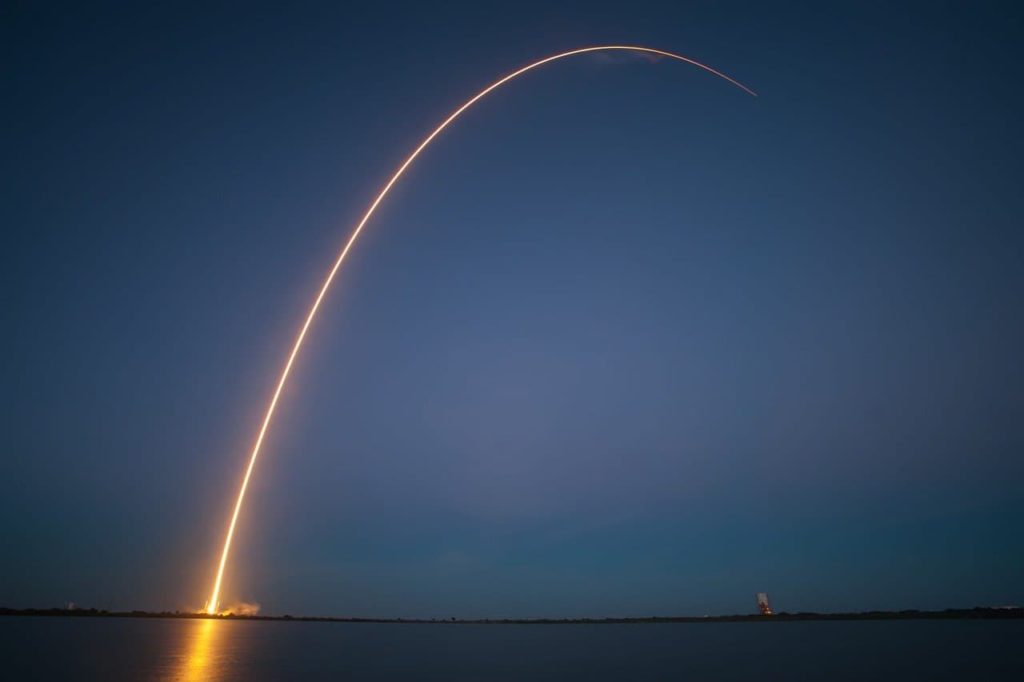
Cargo load is one of the many factors that can influence the time it takes to travel to the Moon.
Does the Moon's orbit affect the time it takes to get there?
We know that the Moon is located at an average distance of 238,855 miles from Earth. However, the trajectory of the Moon’s orbit around the Earth is elliptical, with one side closer to the Earth than the other and an average eccentricity of 0.0549.
Since its path is not perfectly circular, there is a moment when the Moon is as close as possible to the Earth (lunar perigee) at 221,500 miles, and another moment when it is as far away as possible (lunar apogee) at 252,700 miles.
While the distance between the Moon and Earth is an important factor to consider when planning a spacecraft’s trajectory, other considerations come into play regarding the duration of the flight to the Moon.
Related reading : How Far Away is The Moon From Earth Right Now?
The duration of a journey to the Moon varies according to the following factors:
- The chosen itinerary;
- The selected type of propulsion system ;
- The presence or the absence of crew members aboard the spacecraft;
- Whether the spacecraft is scheduled to land on the surface, orbit around the Moon, or just fly by the Moon while heading towards a more distant target.
For example, if the space probe “New Horizons” was travelling at its maximum speed of 36,400 mph while the Moon is at perigee (221,500 miles), the probe would reach the Moon in only 6 hours and 15 minutes! If the Moon was at apogee (252,700 miles), the space probe would take about 6 hours and 50 minutes to pass by the Moon.
How long does it take to fly a manned spacecraft to the moon?
The most popular lunar mission is undoubtedly Apollo 11, during which the astronauts Neil Amstrong, Buzz Aldrin and Michael Collins travelled to the Moon for the first time. After blasting off from the Kennedy Space Center on July 16, 1969, the astronauts landed on the lunar surface on July 20, 1969, and the journey took 75 hours and 49 minutes.
To date, the Apollo 8 mission still holds the record for the shortest travel time ever achieved by a spacecraft carrying astronauts on board (69 hours et 8 minutes). In total, NASA conducted 6 lunar landings during the Apollo program.
Although other countries have conducted orbital placements as well as landings of unmanned spacecraft, the United States remains to this day the only country to have successfully landed astronauts on the Lunar surface.
As you can see in the table below, the time taken to reach the Moon is different for each Apollo mission. There are several explanations for this:
- The purpose of some missions was only to orbit the Moon rather than land on it.
- NASA was constantly researching and testing for the best possible trajectory.
- Some missions involved transporting very heavy equipment, such as the lunar rover.
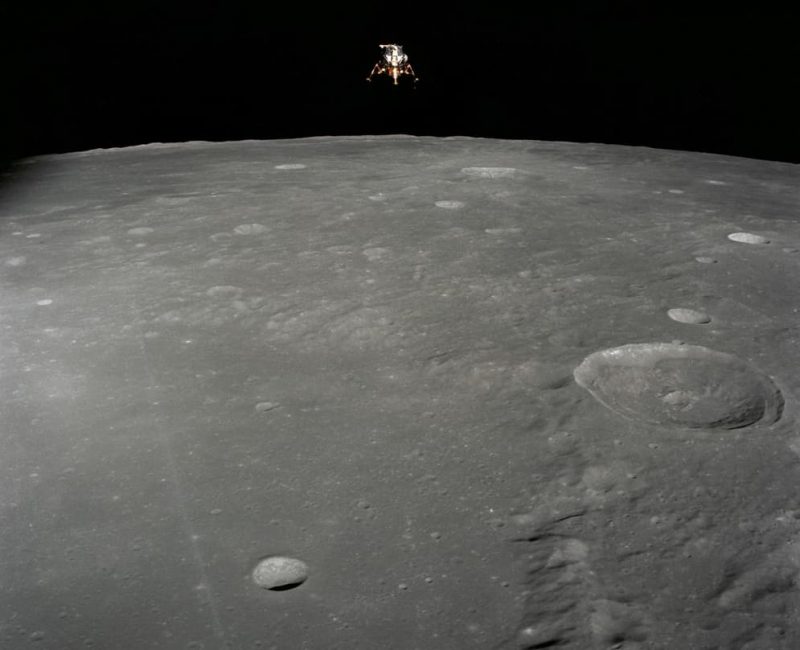
The Apollo 12 mission arrived on the Moon after a voyage that took three and a half days.
How long does it take to send an unmanned spacecraft to the moon?
Even for unmanned space probes, there is no such thing as a consistent travel time… It all depends on whether the spacecraft is just passing by the Moon, whether it is intended to be placed into orbit or to land on the surface. New Horizons holds the record for the shortest trip to the Moon: 8 hours and 35 minutes!
The record for the longest journey to the Moon is held by SMART-1, a space probe engineered by the European Space Agency: it took a full year to reach the Moon! Although SMART-1 is the slowest spacecraft to ever reach the Moon, it remains the most fuel-efficient spacecraft in history.
How long did it take Artemis 1 to reach the Moon?
Artemis 1 was launched on November 16 2022, at 6:47 am GMT (1:47 EST). This flight was the first in a series of missions planned by NASA as part of its Artemis program, which aims to land the first woman and next man on the moon by 2024. The launch vehicle used for the mission was the SLS (Space Launch System), carrying the Orion spacecraft into space.
After a relatively smooth journey, Orion officially entered lunar orbit on November 21, at 7:57 am ET (12:57 UTC). In total, Artemis took 5 days, 1 hour, and 10 minutes to travel from Earth to the Moon. It is not the quickest flight we’ve seen, but the main goals were:
- Test the flight systems
- Test the new technology that was developed for the mission
- Provide data on how the SLS performed, as well as insights into the health of Orion’s systems and overall performance.
- Prepare for crewed missions starting next year.
Related Article: How Much of Space Have We Explored So Far?
In summary, the time it takes to reach the Moon is about 3 days on average for manned spacecraft. On the other hand, for unmanned spacecraft, the travel time can vary considerably depending on the mission objectives. They usually reach their destination much faster.
I eagerly look forward to the launch of the next lunar mission scheduled for 2024. Mankind will return to the lunar surface for the first time in 40 years! And this time, a woman will be part of the crew! How amazing!
Is it possible that 40 years of technological progress will significantly reduce the time it takes to reach the Moon? Perhaps the new private space companies, such as SpaceX, Virgin Galactic and Blue Origin, will beat all previous records? We’ll find out the answer in a few years…!

Written by Tom Urbain
I’ve been fascinated by space and astronomy from a very young age. When I’m not watching space-themed documentaries, movies or TV series, I spend most of my free time in my backyard admiring the planets and galaxies with my telescope.
Explore more space travel stories 🚀
This moon-related story is part of our collection of astronomy articles . If this piece sparked your interest, you’re sure to enjoy the fascinating insights offered in our subsequent articles.
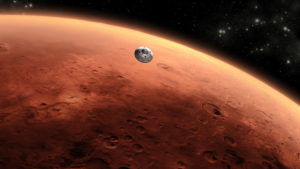
The Duration of a Voyage to Mars: A Detailed Analysis
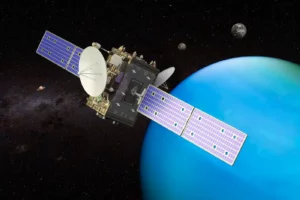
How long does it take to reach the Uranus?
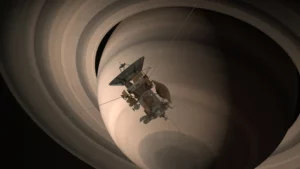
Countdown to Saturn: The Travel Time Involved
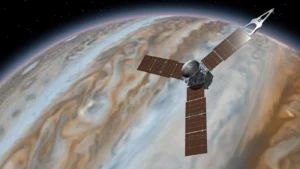
Traveling to Jupiter: How Long is the Journey?
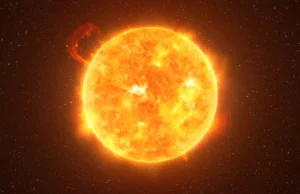
How Long Does it Take to Get to The Sun?
NASA’s Voyager 1 Resumes Sending Engineering Updates to Earth

NASA’s Voyager 1 spacecraft is depicted in this artist’s concept traveling through interstellar space, or the space between stars, which it entered in 2012.
After some inventive sleuthing, the mission team can — for the first time in five months — check the health and status of the most distant human-made object in existence.
For the first time since November , NASA’s Voyager 1 spacecraft is returning usable data about the health and status of its onboard engineering systems. The next step is to enable the spacecraft to begin returning science data again. The probe and its twin, Voyager 2, are the only spacecraft to ever fly in interstellar space (the space between stars).
Voyager 1 stopped sending readable science and engineering data back to Earth on Nov. 14, 2023, even though mission controllers could tell the spacecraft was still receiving their commands and otherwise operating normally. In March, the Voyager engineering team at NASA’s Jet Propulsion Laboratory in Southern California confirmed that the issue was tied to one of the spacecraft’s three onboard computers, called the flight data subsystem (FDS). The FDS is responsible for packaging the science and engineering data before it’s sent to Earth.

After receiving data about the health and status of Voyager 1 for the first time in five months, members of the Voyager flight team celebrate in a conference room at NASA’s Jet Propulsion Laboratory on April 20.
The team discovered that a single chip responsible for storing a portion of the FDS memory — including some of the FDS computer’s software code — isn’t working. The loss of that code rendered the science and engineering data unusable. Unable to repair the chip, the team decided to place the affected code elsewhere in the FDS memory. But no single location is large enough to hold the section of code in its entirety.
So they devised a plan to divide the affected code into sections and store those sections in different places in the FDS. To make this plan work, they also needed to adjust those code sections to ensure, for example, that they all still function as a whole. Any references to the location of that code in other parts of the FDS memory needed to be updated as well.
The team started by singling out the code responsible for packaging the spacecraft’s engineering data. They sent it to its new location in the FDS memory on April 18. A radio signal takes about 22 ½ hours to reach Voyager 1, which is over 15 billion miles (24 billion kilometers) from Earth, and another 22 ½ hours for a signal to come back to Earth. When the mission flight team heard back from the spacecraft on April 20, they saw that the modification worked: For the first time in five months, they have been able to check the health and status of the spacecraft.
Get the Latest News from the Final Frontier
During the coming weeks, the team will relocate and adjust the other affected portions of the FDS software. These include the portions that will start returning science data.
Voyager 2 continues to operate normally. Launched over 46 years ago , the twin Voyager spacecraft are the longest-running and most distant spacecraft in history. Before the start of their interstellar exploration, both probes flew by Saturn and Jupiter, and Voyager 2 flew by Uranus and Neptune.
Caltech in Pasadena, California, manages JPL for NASA.
News Media Contact
Calla Cofield
Jet Propulsion Laboratory, Pasadena, Calif.
626-808-2469
There’s No Way to Make Space Travel Good for Planet Earth Right Now
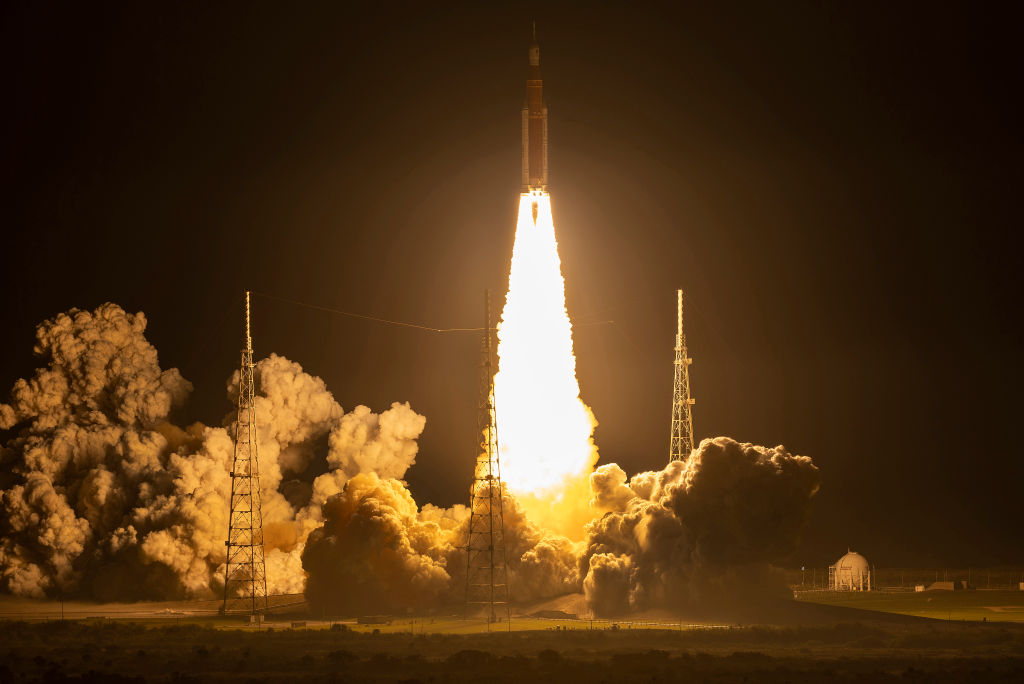
S paceX has never been reluctant to brag, especially when it comes to its celebrated Falcon 9 rocket. Since 2010, as a company toteboard shows, 217 Falcon 9s have flown, with 61 launches in 2022 alone, making it the workhorse of the current global space fleet. So what’s not to like? Plenty, actually—at least if you care about the environment.
The Falcon 9 uses a fuel mixture of liquid oxygen and simple kerosene, and while the oxygen does not do any harm to the skies, the black soot created by the burning kerosene is injected directly into the stratosphere—the layer of air ranging from 12 km (7.5 mi.) to 50 km (31 mi.) above the Earth. There the soot lingers for up to five years , absorbing heat, contributing to climate change, and damaging the ozone layer, which exposes the planet to dangerous ultraviolet (UV) radiation. And SpaceX is not remotely alone.
According to a study by the National Oceanic and Atmospheric Administration (NOAA), global rocket launches (of which there were 180 last year, the study notes) inject about 1,000 tons of soot into the upper atmosphere per year. That will only get worse, NOAA warns, as the industry continues to expand. “The bottom line is projected increases in rocket launches could expose people in the Northern Hemisphere [where most rocket launches take place] to increased harmful UV radiation,” environmental scientist Christopher Maloney, the study’s lead author, said in a statement .
By themselves, rocket launches are small contributors to overall atmospheric pollutants. The aviation industry burns 100 times more fuel each year than all of the rockets launched globally combined. But there is a key atmospheric difference: airplanes fly in the troposphere about 11 km (6.6 mi.) above the ground. Soot precipitates quickly from this range compared to stratospheric soot which sticks around much longer. Indeed, according to the NOAA report, a single passenger aboard a rocket is responsible for 100 times more climate-changing pollution than a passenger aboard an airplane.
Not only does all of this warm the planet and damage the ozone, the NOAA scientists warn, but the change in temperatures can also slow subtropical jet streams , worsening summer monsoons in Africa and India. “We need to learn more about the potential impact of hydrocarbon-burning engines on the stratosphere and on the climate at the surface of the Earth,” said Maloney.
A version of this story also appears in the Climate is Everything newsletter. To sign up, click here .
The type of fuel used in the rockets can make a difference. SpaceX’s massive, 33-engine Starship spacecraft , for example, uses methane in place of kerosene. While methane is a powerful greenhouse gas by itself, it does burn cleaner than kerosene, putting out less black soot. Blue Origin’s New Shepard rocket is cleaner still, burning liquid oxygen and liquid hydrogen, and producing only water vapor as an exhaust—water vapor in the upper atmosphere still traps and retains heat, but not nearly as much as black soot, methane, or carbon dioxide do.
None of this means that the private rocket industry or growing space powers like China, India, and the United Arab Emirates—to say nothing of the U.S.—will be slowing down their launch schedules or becoming less pollution-intensive any time soon. Indeed, NASA’s new Space Launch System moon rocket, which first launched in November 2022, is an especially dirty machine. While it uses a liquid oxygen-hydrogen mix in its four main engines, its two attached solid fuel engines, which account for most of the vehicle’s thrust, produce the ozone-damaging pollutant chlorine.
The thriving space industry is typically seen as a boon for both the economy and for human exploration—and it is. But the launching of a monster rocket—with monster exhaust—like SpaceX’s anticipated Starship is a reminder that there can be too much of a good thing. If we keep increasing not just the size of rockets but the number of launches, we do so at a price; and as with so many other things, it is the climate that pays.
More Must-Reads From TIME
- The 100 Most Influential People of 2024
- Coco Gauff Is Playing for Herself Now
- Scenes From Pro-Palestinian Encampments Across U.S. Universities
- 6 Compliments That Land Every Time
- If You're Dating Right Now , You're Brave: Column
- The AI That Could Heal a Divided Internet
- Fallout Is a Brilliant Model for the Future of Video Game Adaptations
- Want Weekly Recs on What to Watch, Read, and More? Sign Up for Worth Your Time
Write to Jeffrey Kluger at [email protected]

- [ April 25, 2024 ] NASA astronauts arrive at Kennedy Space Center ahead of Boeing Starliner Crew Flight Test Atlas 5
- [ April 23, 2024 ] Rocket Lab launches NASA, Korean payloads on Electron flight Electron
- [ April 23, 2024 ] SpaceX completes 300th Falcon booster landing during Starlink mission Falcon 9
- [ April 22, 2024 ] News from the Press Site: NASA explores new path for Mars Sample Return, Dragonfly mission to Titan gets green light News
- [ April 18, 2024 ] SpaceX completes 40th Falcon 9 launch of the year with Starlink mission Falcon 9
NASA astronauts arrive at Kennedy Space Center ahead of Boeing Starliner Crew Flight Test
For the first time since the end of the shuttle program, a trio of T-38 jets cruised down the former Shuttle Landing Facility carrying astronauts who were preparing for launch. As they climbed out of their aircraft, NASA astronauts Butch Wilmore and Suni Williams, each donned back ball caps emblazoned with “Crew Flight Test,” the name of their forthcoming mission.
The pair will serve as the commander and pilot respectively as they fly Boeing’s Starliner spacecraft to the International Space Station no earlier than May 6. As the mission name suggests, this will be the first time the spacecraft ferries astronauts to the orbiting outpost.
“We love Florida. We love Kennedy Space Center because this is where you launch humans into space,” Wilmore said. “And the opportunity finally to fly in here again in our T-38s and we know that in less than two weeks, the next flight we take, we’ll be laying on our backs this time when we launch into the heavens and we leave this planet.”
Wilmore and Williams were joined by some of the T-38 training crew as well as fellow NASA astronauts Mike Fincke, the backup astronaut for the CFT mission, and Jessica Wittner, a member of the class of the 2021 astronaut candidate class.
With them in spirit was the last crew to fly a test mission for NASA: Bob Behnken and Doug Hurley of the SpaceX Demo-2 flight. During their remarks to the press on Thursday, Williams said they offered words of comfort.
“As a matter of fact, I just got a text from Bob last night and he was pretty pumped that we’re coming down here,” Williams said. “The one thing we were chatting about is May 6 is our launch day. There’s a lot of things between now and then. May 6 isn’t magical and he said, ‘If you get a scrub it actually is a little bit nice because it sort of takes the pressure off.’”
Standing in front of their T-38’s Williams reflected on what was going through her mind as they flew over KSC and by the launch pad at Space Launch Complex 41 where they will launch in less than two weeks.
“I was part of the original cadre that got to put the topping piece on the crew access arm for pad 41 that we’re going to fly out of,” Williams said. “And to see not only see that pad transition while they were flying other Atlas 5’s, doing other payloads, to have them turn that into a human-rated pad is just incredible.”
https://twitter.com/AstroIronMike/status/1783557592528072821
Certification nearly complete
The arrival of the CFT astronauts comes on the second day of the flight readiness review at NASA’s Kennedy Space Center. Teams across NASA, Boeing and ULA were poring over data regarding Starliner itself and the availability of the ISS to receive the spacecraft. They ultimately polled “go” to move forward with the mission and target a May 6 launch date.
“The team has practiced [simulations], run models, but there’s nothing like flying in the space environment,” said Jim Free, NASA’s associate administrator. “We’re going to learn from this test flight. I’m looking forward to us increasing our knowledge and understand and proving a new spacecraft.”
Before Starliner can arrive at the orbiting outpost, SpaceX needs to undock the Cargo Dragon spacecraft that has been stationed at the space-facing port of the Harmony module and bring it back to splash down off the coast of Florida. On Thursday, NASA said it was punting the undocking procedure from Friday to Sunday “due to unfavorable weather conditions in the splashdown zones.”
#Starliner #CFT flag raising ceremony this morning. Let’s go baby! 🚀 pic.twitter.com/8Vy5VG95pB — Flux 🇺🇦 (@therealdjflux) April 25, 2024
Following that, the three astronauts and one cosmonaut of the Crew-8 mission will hop back into their Crew Dragon, named Endeavour, and relocate it from the Earth-facing port to the space-facing port to clear the way for Starliner.
“On the station side, we’ve intentionally cleared our flight plan, our vehicle traffic and our schedules, but we’ve got a really large window to accommodate the CFT mission,” said Dana Weigel, NASA ISS Program manager. “So if, for whatever reason, we need more time for the mission in the run-up to launch or onboard, there is no issue at all accommodating a longer mission duration.”
The mission profiled is designed to last a little more than a week. If for some reason they are not able to launch on May 6, they do have backup dates on May 7, 10 and 11.
Steve Stich, the manager of NASA’s Commercial Crew Program, noted that there are a couple key items that need to be completed between now and launch day. He said at Space Launch Complex 41, they will be swapping out a valve that provides replenishment of liquid oxygen for the Atlas 5’s first stage.
Stich noted that when they inspected the valve, ULA found “some particulate matter in the system,” which they wanted to check more closely. Upon further inspection, they decided that it made sense to replace the valve.
“And this is on the ground side. This is not on the flight vehicle side. We see this at lots of different launch pads,” Stich said. “We had similar kinds of problems with shuttle and so, we’ll work through it and clear that.”
He added that “out of an abundance of caution,” they are also going to review the contingency plans on the Starliner parachute system. Specifically, they are looking at the two small parachutes that pull off the forward heat shield to expose the drogue parachutes. The drogues are what initially slow down the vehicle before the main parachutes deploy.
“If one of those those two forward heat shield parachutes doesn’t deploy, we want to go back and check that analysis one more time with the latest trajectory, the latest vehicle, the latest properties and the center of gravity,” Stich said. “So, those are really the two big things that I say we have in work, but other than that, we’ve closed out the certification.”
The international partners of the space station also polled ‘go’ regarding their readiness to accept the Starliner as a visiting spacecraft.
On Friday, teams will go through essentially a dry dress rehearsal of the mission, which will include having the crew don their flight suits and go through the process that they will experience on launch day. Asked about their confidence in their ticket to ride, Wilmore said they are ready.
“One thing I’ve heard from these two guys on the right time and again, we will not fly until we’re ready. And that’s from the top,” Wilmore said, gesturing to members of Boeing leadership. “We’ve had a few delays because we weren’t ready.”
“We wouldn’t be here if we weren’t ready. We are ready, the spacecraft’s ready and the teams are ready.”
The results are in and after an extensive review of the mission and our readiness, we’re GO to proceed with launch preparations, targeting a late May 6 EDT/early May 7 UTC launch! https://t.co/oXeKo4Ef3a — Ed Van Cise (@Carbon_Flight) April 25, 2024
- Butch Wilmore
- Commercial Crew Program
- Suni Williams
Related Articles
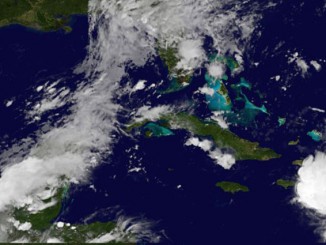
Tropical weather postpones Monday’s Atlas 5 rocket launch
Plans to launch a Navy communications satellite aboard an Atlas 5 rocket early Monday have been interrupted by Tropical Storm Erika, an unpredictable cyclone with its sights on Florida.
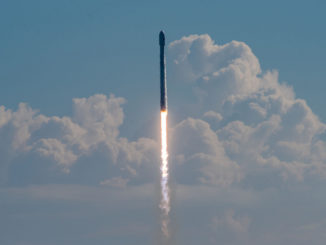
SpaceX beats hurricane with smooth launch of military’s X-37B spaceplane
Succeeding on a one-shot launch attempt before Hurricane Irma shuts down the Cape Canaveral spaceport, a SpaceX Falcon 9 rocket thundered into orbit Thursday with the U.S. Air Force’s X-37B spaceplane, a reusable robotic mini-shuttle that could stay aloft for years with clandestine on-board experiments.
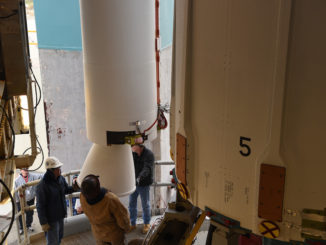
Photos: Final Delta 2 rocket assembled for launch in California
The step-by-step stacking of United Launch Alliance’s final Delta 2 rocket was completed in June at Vandenberg Air Force Base in California for liftoff Sept. 15 with an Earth science satellite for NASA.
© 1999-2024 Spaceflight Now Inc
Why does NASA want a time zone on the moon?
NASA has been tasked with determining a standard time zone for the moon, but it’s more complicated than you might think.
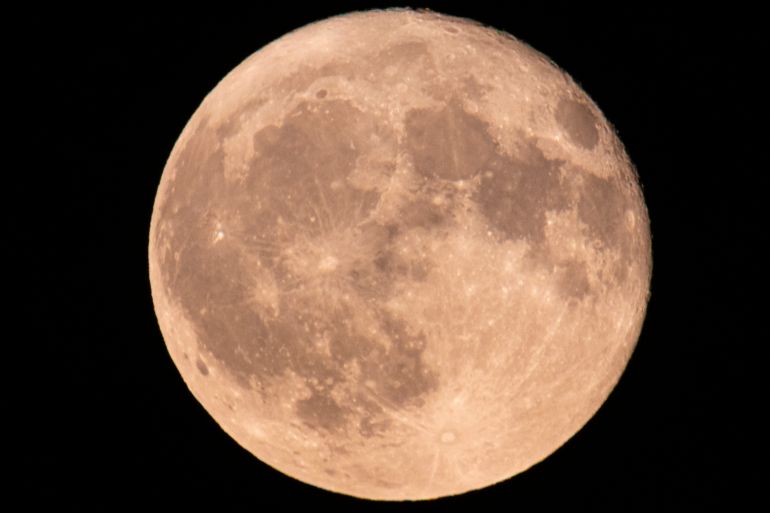
The United States government has tasked its space agency, NASA, with establishing a standard time zone for the moon, which will be known as Coordinated Lunar Time (CLT).
In a memo issued on April 2, the US Office of Science and Technology Policy (OSTP) stated: “Federal agencies will develop celestial time standardisation with an initial focus on the lunar surface and missions operating in Cislunar space [the area within the moon’s orbit], with sufficient traceability to support missions to other celestial bodies.” “Traceability” means that CLT can be kept in sync with time zones on Earth.
Keep reading
Russia’s angara a5 rocket blasts off into space after two aborted launches, photos: mexico, us, canada mesmerised by rare total solar eclipse, moment total solar eclipse occurs in north america, millions across north america await total solar eclipse.
The memo outlined the following features for the new CLT:
- Traceability to Coordinated Universal Time (UTC – a compromise for both English and French speakers);
- Accuracy sufficient to support precision navigation and science;
- Resilience to loss of contact with Earth (meaning CLT can operate independently of Earth); and
- Scalability to space environments beyond the Earth-moon system (meaning other space stations beyond the moon would be able to use CLT as well).
Don’t expect your favourite time zone and calendar apps to have CLT as an option yet; NASA has until the end of 2026 to establish CLT.
Why does the moon need its own time zone?
In layman’s terms, we need a reliable “lunar time” earth-syncing system because lower gravity on the moon causes time to move slightly faster there than on Earth – by just 58.7 microseconds (there are 1 million microseconds in a single second) faster within every 24 Earth hours.
This is not science fiction, even though it is a main feature of Hollywood blockbusters such as Interstellar. Known as “gravitational time dilation”, the passage of time is impacted by gravity.
Although small, these time discrepancies can cause issues with syncing satellites and space stations in lunar orbit.
An unnamed OSTP official told Reuters: “Imagine if the world wasn’t syncing their clocks to the same time – how disruptive that might be and how challenging everyday things become.”
How would we tell time on the moon?
Earth uses UTC or Coordinated Universal Time to sync time zones around the world. UTC is determined by more than 400 atomic clocks that are maintained in national “time laboratories” in about 30 countries around the world. An atomic clock uses the vibrations of atoms to achieve extreme precision in keeping track of time.
Similar atomic clocks would be placed on the moon to get an accurate time reading.

Known as Positioning, Navigation and Timing (PNT), this precision-timing system allows communications systems to measure and keep accurate timing. The Ordnance Survey, the British organisation that has been producing maps since 1791, explains that PNT has three core elements:
- Positioning – the ability to precisely determine one’s location and orientation, predominantly two dimensionally on a printed map, although three-dimensional orientation can be determined when required.
- Navigation – the ability to determine both the current and desired position (either relative or absolute), and apply corrections to course, orientation and speed to reach a desired position from anywhere in the world, from sub-surface (below the Earth’s surface) to surface, and from surface to space.
- Timing – the ability to maintain accurate and precise time from anywhere in the world.
Does NASA have plans for time zones in other parts of outer space?
Although there has been no mention of time zones on other planets, in 2019, NASA’s Deep Space Atomic Clock (DSAC) mission tested an atomic clock to improve spacecraft navigation in deep space. The DSAC mission, on SpaceX’s Falcon Heavy rocket, was launched on June 22, 2019. The rocket tested the atomic clock in Earth’s orbit for one year.
Typically, spacecraft keep accurate time by bouncing signals to atomic clocks on Earth and then the signal is sent back to the spacecraft. In this mission, the on-board atomic clock was tested to keep precise time without relying on this two-way communication between the spacecraft and the atomic clocks on Earth. The accuracy of the timing is tied to getting accurate positioning, while helping the spacecraft reach the intended location in space successfully.
As NASA’s Jet Propulsion Laboratory, the centre for robotic exploration of the solar system, explains: “A two-way system that sends a signal from Earth to a spacecraft, back to Earth and then to the spacecraft again would take an average of 40 minutes. Imagine if the GPS on your phone took 40 minutes to calculate your position. You might miss your turn or be several exits down the highway before it caught up with you. If humans travel to the Red Planet [Mars], it would be better if the system was one-way, allowing the explorers to immediately determine their current position rather than waiting for that information to come back from Earth.”
The mission successfully ended in 2021, with the on-board atomic clock maintaining the correct timing and navigational positioning.
Superradiant atoms could push the boundaries of how precisely time can be measured
Superradiant atoms can help us measure time more precisely than ever. In a new study, researchers from the University of Copenhagen present a new method for measuring the time interval, the second, mitigating some of the limitations that today's most advanced atomic clocks encounter. The result could have broad implications in areas such as space travel, volcanic eruptions and GPS systems.
The second is the most precisely-defined unit of measurement, compared to other base units such as the kilogram, meter, and degree Kelvin. Time is currently measured by atomic clocks in different places around the world, which together, tell us what time it is. Using radio waves, atomic clocks continuously send signals that synchronize our computers, phones and wristwatches.
Oscillations are the key to keeping time. In a grandfather clock, these oscillations are from a pendulum's swinging from side to side every second, while in an atomic clock, it is a laser beam which corresponds to an energy transition in strontium and oscillates about a million billion times per second.
But according to PhD fellow Eliot Bohr from the Niels Bohr Institute -- great-grandson of Niels Bohr -- even atomic clocks could become more precise. This is because the detection laser, used by most modern atomic clocks to read the oscillation of atoms, heats up the atoms so much that they escape -- which degrades precision.
"Because the atoms constantly need to be replaced with fresh new atoms, while new atoms are being prepared, the clock loses time ever so slightly.Therefore, we are attempting to overcome some of the current challenges and limitations of the world's best atomic clocks by, among other things, reusing the atoms so that they don't need to be replaced as often," explains Eliot Bohr who was employed at the Niels Bohr Institute when he did the research, but who is now PhD fellow at the University of Colorado.
He is the lead author of a new study published in the scientific journal Nature Communications , which uses an innovative and perhaps more efficient way of measuring time.
Superradiance and cooling to absolute zero
The current methodology consists of a hot oven that spits roughly 300 million strontium atoms into an extraordinarily chilly ball of cold atoms known as a magneto-optical trap, or MOT. The temperature of these atoms is approximately -273 °C -- very near absolute zero -- and there are two mirrors with a light field in between them to enhance the atomic interactions. Together with his research colleagues, Bohr has developed a new method to read out the atoms.
"When the atoms land in the vacuum chamber, they lie completely still because it is so cold, which makes it possible to register their oscillations with the two mirrors at opposing ends of the chamber," explains Eliot Bohr.
The reason why the researchers don't need to heat the atoms with a laser and destroy them is thanks to a quantum physical phenomenon known as 'superradiance'. The phenomenon occurs when the group of strontium atoms is entangled and at the same time emits light in the field between the two mirrors.
"Themirrors cause the atoms to behave as a single unit. Collectively, they emit a powerful light signal that we can use to read out the atomic state, a crucial step for measuring time. This method heats up the atoms minimally, so It all happens without replacing the atoms, and this has the potential to make it a more precise measurement method," explains Bohr.
GPS, space missions and volcanic eruptions
According to Eliot Bohr, the new research result may be beneficial for developing a more accurate GPS system. Indeed, the roughly 30 satellites that constantly circle Earth and tell us where we are need atomic clocks to measure time.
"Whenever satellites determine the position of your phone or GPS, you are using an atomic clock in a satellite. The precision of the atomic clocks is so important that If that atomic clock is off by a microsecond, it means an inaccuracy of about 100 meters on the Earth's surface," explains Eliot Bohr.
Future space missions are another area where the researcher foresees more precise atomic clocks making a significant impact.
"When people and crafts are sent out into space, they venture even further away from our satellites. Consequently, the requirements for precise time measurements to navigate in space are much greater," he says.
The result could also be helpful in the development of a new generation of smaller, portable atomic clocks that could be used for more than "just" measuring time.
"Atomic clocks are sensitive to gravitational changes and can therefore be used to detect changes in Earth's mass and gravity, and this could help us predict when volcanic eruptions and earthquakes will occur," says Bohr.
Bohr emphasizes that while the new method using superradiant atoms is very promising, it is still a "proof of concept" which needs further refinement. .
The research was conducted by the team of Jörg Helge Müller and Jan Thomsen at the Niels Bohr Institute, in collaboration with PhD students Sofus Laguna Kristensen and Julian Robinson-Tait, and postdoc Stefan Alaric Schäffer. The project also included contributions from theorists Helmut Ritsch and Christoph Hotter from the University of Innsbruck, as well as Tanya Zelevinsky from Columbia University.
- Engineering
- Weapons Technology
- Nanotechnology
- Quantum Physics
- Global Positioning System
- Electron configuration
- Time in physics
- Oscillation
- Special relativity
- Constructal theory
Story Source:
Materials provided by University of Copenhagen - Faculty of Science . Note: Content may be edited for style and length.
Journal Reference :
- Eliot A. Bohr, Sofus L. Kristensen, Christoph Hotter, Stefan A. Schäffer, Julian Robinson-Tait, Jan W. Thomsen, Tanya Zelevinsky, Helmut Ritsch, Jörg H. Müller. Collectively enhanced Ramsey readout by cavity sub- to superradiant transition . Nature Communications , 2024; 15 (1) DOI: 10.1038/s41467-024-45420-x
Cite This Page :
Explore More
- Advance in Heart Regenerative Therapy
- Bioluminescence in Animals 540 Million Years Ago
- Profound Link Between Diet and Brain Health
- Loneliness Runs Deep Among Parents
- Food in Sight? The Liver Is Ready!
- Acid Reflux Drugs and Risk of Migraine
- Do Cells Have a Hidden Communication System?
- Mice Given Mouse-Rat Brains Can Smell Again
- How Do Birds Flock? New Aerodynamics
- Cancer: Epigenetic Origin Without DNA Mutation
Trending Topics
Strange & offbeat.
Interstellar astronauts would face years-long communication delays due to time dilation
The laws of physics mean that communication with near-light-speed spacecraft would be very challenging.

Due to the mind-blowing distances and speeds required, interstellar travel would be extraordinarily difficult, if not impossible, for humanity to achieve. But new research highlights yet another challenge: communication blackouts.
The next-closest star system to our own, Alpha Centauri , is over 4 light-years away, so barring any fancy sci-fi technological revolution in the next few centuries, if we want to spread among the stars, we'll have to do it the "slow" way.
That means we'd need some sort of propulsion method that could get us close to, but not exceed, the speed of light . But even if we were to achieve this ambitious goal, this futuristic mode of transportation would present all sorts of communication challenges, scientists explain in a paper recently uploaded to the preprint database arXiv .
The first problem is that light itself can only travel at a finite speed. While this doesn't severely hinder communication near Earth, engineers already have to deal with this challenge when communicating with probes sent across the solar system . For example, messages take minutes to arrive at Mars and hours to reach the outer planets. For even longer-distance communication — like an imagined scenario of a spacecraft sent to some star system many light-years away — it would mean any message would take years to reach the craft.
Related: Is interstellar travel really possible?
But that's not the only hurdle. Special relativity teaches us that clocks are not synchronized across the universe. Travelers on board the spacecraft would experience time dilation, in which time would flow more slowly than it would for people on Earth. This effect is already measurable; for example, it needs to be taken into account for synchronizing signals from GPS satellites.
But in our imagined scenario, our travelers are moving as close to the speed of light as possible. This is absolutely essential for propagation out into the galaxy . Because of time dilation, the passengers would not experience the years and decades of travel; for them, depending on how fast they moved, only weeks or months might pass.
Get the Space.com Newsletter
Breaking space news, the latest updates on rocket launches, skywatching events and more!
This time dilation would introduce serious issues for coordinating messages, which requires a significant amount of math. While annoying, that wouldn't be the hardest part of interstellar travel. Instead, it's that spacecraft traveling at near light speed would suffer severe communication blackout periods.
In their paper, the researchers investigated two hypothetical interstellar-travel scenarios. In the first, travelers would continue to accelerate their spacecraft at a constant 1 g of acceleration — the same acceleration provided naturally by Earth's gravity . This would send their spacecraft ever closer to the speed of light.
Curiously, this kind of constant acceleration would introduce an event horizon . If the people of Earth sent a message to the spacecraft, that message would be limited to the speed of light. It would race ahead toward the spaceship, but in the meantime, the ship also would move away from the signal. If the message were sent soon enough, it would eventually reach the ship after a significant time delay. But if they were to wait too long, the message would never arrive; the spacecraft would always be one step ahead of the message, and from their perspective, signals from Earth would eventually go dark.
The second scenario offers different challenges. The researchers considered the case of a spacecraft sent to a distant destination. At first the spacecraft would constantly accelerate, but midway through its journey, it would flip itself around and decelerate so that it didn't just fly by its target. This scenario would introduce its own set of communication challenges.
First, the spacecraft would stop receiving messages from Earth after a certain amount of time. These messages would eventually reach the spacecraft, but only after it had reached its destination and stopped moving.
On the other hand, the spacecraft would be able to send signals to Earth, and those signals would always reach their targets. Also, signals sent from the destination (say, a colony already set up on the distant planet) would always reach the spacecraft while it was cruising in that direction.
— Interstellar space travel will have language complications for astronauts
— Interstellar travel requires a long-term approach (and humans are too impatient)
— Researchers unlock the keys to designing an interstellar sail
But signals sent from the spacecraft to the destination would not arrive until shortly before the craft itself got there, at which time all of the sent messages would pile up on each other, announcing the arrival of the craft.
These realities mean that communication with near-light-speed spacecraft would be very challenging. All interstellar vehicles must operate independently, because after a certain amount of time, they will be cut off from Earth. If a problem arises, they will be able to tell people on Earth about it, but they won't be able to hear a response.
Also, distant colonies wouldn't know about the launch of a spacecraft in their direction until shortly before the craft arrived there.
No matter what, interstellar travel would be a lonely journey.
Join our Space Forums to keep talking space on the latest missions, night sky and more! And if you have a news tip, correction or comment, let us know at: [email protected].

Paul M. Sutter is an astrophysicist at SUNY Stony Brook and the Flatiron Institute in New York City. Paul received his PhD in Physics from the University of Illinois at Urbana-Champaign in 2011, and spent three years at the Paris Institute of Astrophysics, followed by a research fellowship in Trieste, Italy, His research focuses on many diverse topics, from the emptiest regions of the universe to the earliest moments of the Big Bang to the hunt for the first stars. As an "Agent to the Stars," Paul has passionately engaged the public in science outreach for several years. He is the host of the popular "Ask a Spaceman!" podcast, author of "Your Place in the Universe" and "How to Die in Space" and he frequently appears on TV — including on The Weather Channel, for which he serves as Official Space Specialist.
Satellites watch as 4th global coral bleaching event unfolds (image)
Happy Earth Day 2024! NASA picks 6 new airborne missions to study our changing planet
Boeing's Starliner spacecraft is 'go' for May 6 astronaut launch
- VVet1968 The very first science fiction book that I read in the 1950s was Heinlein's "Time for the Stars" which focused on this same problem. Nearly seventy years later I still remember being blown away by the concepts as it was my first introduction to relativity. Sure, it's not an "adult" scifi, but if you've never read it, pick up a copy. Reply
- Helio Interstellar travel is perhaps the best case for using particle entanglement for instant communication since one set of them must be carried to the distant locations. Of course, there has been no means found for a working model, but scientists are very clever, so I bet they’ll get ‘er done…someday, Reply
- billslugg Entanglement cannot be used for communication for two basic reasons. The sender can only send a random message. The timing at the receiving end is either fixed by a predetermined schedule or is indeterminate. Neither a message nor a time can be communicated. Reply
billslugg said: Entanglement cannot be used for communication for two basic reasons. The sender can only send a random message. The timing at the receiving end is either fixed by a predetermined schedule or is indeterminate. Neither a message nor a time can be communicated.
T hese realities mean that communication with near-light-speed spacecraft would be very challenging. All interstellar vehicles must operate independently, because after a certain amount of time, they will be cut off from Earth. If a problem arises, they will be able to tell people on Earth about it, but they won't be able to hear a response .
Also, distant colonies wouldn't know about the launch of a spacecraft in their direction until shortly before the craft arrived there.
- unclefishbits I have a silly saying: "No internet is fine. Having internet is great" Bad internet is a frustrating nightmare". Now put this at an existential level of loneliness and hope, and you've ramped up that situation to horrific levels. I'd just right off that comms won't work, and make sure you plan ahead to never exist in context of the earth or human race, ever again. Seeding the galaxy is going to be quite lonely. And we thought Tom Hanks in Castaway seemed crazed with lack of connections. Time to rewatch Aniara. Reply
Helio said: In a pair of entangled particles, my limited understanding is that whenever one particle collapses, say "heads", the other will instantly collapse to say "tails", regardless of distance. This would allow for excellent and instant communication. BUT, of course, the problem is getting the "first" one to say "heads" in a way that doesn't break their entanglement. My hope is that someone will find a way to do it.
Helio said: Also there are some interesting points raised in this article: " But signals sent from the spacecraft to the destination would not arrive until shortly before the craft itself got there, at which time all of the sent messages would pile up on each other, announcing the arrival of the craft." This is interesting because the travelers who, say reach alpha Centauri in one year, will argue their travel transmissions were never more than 1 year from Earth. But those on Earth would, I think, disagree and say that, for instance, when the travelers were 6 months out (half way) then Earth would see the transmission from 2.15 lyrs distance, so it would take 2.15 years to get the transmission, which is 1.15 years after the ship arrived. So, WAIM ( What Am I Missing?). Under SR, I don't see how this is true, eventually any signal sent will take one year for every lightyear distance the ship is from Earth when the transmission was sent. WAIM? This is puzzling as well. Assuming SR effects reduce their travel time (or distance) then any Earth broadcast will come after their arrival, not before. If the spacecraft sends a transmission to the destination after it has slowed enough, then this would make sense, admittedly.
dgmesser said: This would violate Einstein's principle that information cannot travel faster in an inertial frame than the speed of light. If that is violated, it would be a very big deal.
Helio said: "Spooky action at a distance", as Einstein called it. "Instantaneous" action has been demonstrated to be correct, thanks greatly to John Bell.
- View All 35 Comments
Most Popular
- 2 Russian cosmonauts make quick work of space station spacewalk
- 3 Curiosity rover may be 'burping' methane out of Mars' subsurface
- 4 Boeing Starliner 1st astronaut flight: Live updates
- 5 Lego reveals NASA Artemis rocket, Milky Way galaxy sets coming in May
- Election 2024
- Entertainment
- Newsletters
- Photography
- Personal Finance
- AP Investigations
- AP Buyline Personal Finance
- AP Buyline Shopping
- Press Releases
- Israel-Hamas War
- Russia-Ukraine War
- Global elections
- Asia Pacific
- Latin America
- Middle East
- Election Results
- Delegate Tracker
- AP & Elections
- Auto Racing
- 2024 Paris Olympic Games
- Movie reviews
- Book reviews
- Personal finance
- Financial Markets
- Business Highlights
- Financial wellness
- Artificial Intelligence
- Social Media
Japan announces plans to launch upgraded observation satellites on new flagship rocket’s 3rd flight
FILE - A Mitsubishi Heavy Industries staff member stands next to the top of the first stage of a H3 rocket, inside the Mitsubishi Heavy Industries’ Nagoya Aerospace Systems Works Tobishima Plant in Tobishima, Aichi prefecture Thursday, March 21, 2024. Japan’s space agency announced Friday, April 26, that it will launch its new flagship rocket H3 on June 30 carrying an observation satellite for disaster response and security purposes, a key mission that it had failed in its debut flight last year.(AP Photo/Mari Yamaguchi)
FILE - JAXA H3 rocket project managers Masashi Okada, right, and Mayuki Niitsu brief journalists in front of the second stage of a H3 rocket, set for a full-fledged launch later this year after two test flights, inside the Mitsubishi Heavy Industries’ Nagoya Aerospace Systems Works Tobishima Plant in Tobishima, Aichi prefecture Thursday, March 21, 2024. Japan’s space agency announced Friday, April 26, that it will launch its new flagship rocket H3 on June 30 carrying an observation satellite for disaster response and security purposes, a key mission that it had failed in its debut flight last year. (AP Photo/Mari Yamaguchi, File)
- Copy Link copied
TOKYO (AP) — Japan’s space agency announced Friday a plan to launch a major upgrade to its satellite imaging system, as a new flagship rocket is put to the test for a third time.
The Japan Aerospace Exploration Agency that an H3 rocket will be launched from the Tanegashima Space Center, on a southwestern Japanese island, early afternoon on June 30, with a launch window that runs through the end of July.
The rocket will be carrying an Advanced Land Observation Satellite, ALOS-4, tasked primarily with Earth observation and data collection for disaster response and mapmaking, as well as with monitoring military activity, such as missile launches, with an infrared sensor developed by the Defense Ministry. The ALOS-4 is a successor to the current ALOS-2 and can observe a much wider area.
The launch will be the H3’s third, coming after a failed debut in March 2023 and a successful launch on Feb. 17. During the first attempt, the rocket’s second stage engine did not ignite and the rocket had to be destroyed along with its main payload, a satellite that was supposed to be the ALOS-3.
During H3 No. 2’s successful test flight, it carried two commercially-developed observation microsatellites and an ALOS mockup.
JAXA and its main contractor Mitsubishi Heavy Industries have been developing H3 as a successor to its current mainstay, H-2A, which is set to retire after two more flights. MHI will eventually take over H3 production and launches from JAXA and hopes to make it commercially viable.
Japan sees a stable, commercially competitive space transport capability as key to the country’s space program and national security.
The 57-meter (187-foot) long H3 rocket is designed to carry larger payloads than the H-2A at about half its launch cost.
Japan Announces Plans to Launch Upgraded Observation Satellites on New Flagship Rocket's 3rd Flight
Japan’s space agency says it's planning to launch a major upgrade to its satellite imaging system, as a new flagship rocket is put to the test for a third time
Japan Announces Plans to Launch Upgraded Observation Satellites on New Flagship Rocket's 3rd Flight

Mari Yamaguchi
FILE - A Mitsubishi Heavy Industries staff member stands next to the top of the first stage of a H3 rocket, inside the Mitsubishi Heavy Industries' Nagoya Aerospace Systems Works Tobishima Plant in Tobishima, Aichi prefecture Thursday, March 21, 2024. Japan’s space agency announced Friday, April 26, that it will launch its new flagship rocket H3 on June 30 carrying an observation satellite for disaster response and security purposes, a key mission that it had failed in its debut flight last year.(AP Photo/Mari Yamaguchi)
TOKYO (AP) — Japan’s space agency announced Friday a plan to launch a major upgrade to its satellite imaging system, as a new flagship rocket is put to the test for a third time.
The Japan Aerospace Exploration Agency that an H3 rocket will be launched from the Tanegashima Space Center, on a southwestern Japanese island, early afternoon on June 30, with a launch window that runs through the end of July.
The rocket will be carrying an Advanced Land Observation Satellite, ALOS-4, tasked primarily with Earth observation and data collection for disaster response and mapmaking, as well as with monitoring military activity, such as missile launches, with an infrared sensor developed by the Defense Ministry. The ALOS-4 is a successor to the current ALOS-2 and can observe a much wider area.
The launch will be the H3's third, coming after a failed debut in March 2023 and a successful launch on Feb. 17. During the first attempt, the rocket's second stage engine did not ignite and the rocket had to be destroyed along with its main payload, a satellite that was supposed to be the ALOS-3.
During H3 No. 2's successful test flight, it carried two commercially-developed observation microsatellites and an ALOS mockup.
JAXA and its main contractor Mitsubishi Heavy Industries have been developing H3 as a successor to its current mainstay, H-2A, which is set to retire after two more flights. MHI will eventually take over H3 production and launches from JAXA and hopes to make it commercially viable.
Photos You Should See - April 2024

Japan sees a stable, commercially competitive space transport capability as key to the country's space program and national security.
The 57-meter (187-foot) long H3 rocket is designed to carry larger payloads than the H-2A at about half its launch cost.
Copyright 2024 The Associated Press . All rights reserved. This material may not be published, broadcast, rewritten or redistributed.
Join the Conversation
Tags: Associated Press , world news , science
America 2024

Health News Bulletin
Stay informed on the latest news on health and COVID-19 from the editors at U.S. News & World Report.
Sign in to manage your newsletters »
Sign up to receive the latest updates from U.S News & World Report and our trusted partners and sponsors. By clicking submit, you are agreeing to our Terms and Conditions & Privacy Policy .
You May Also Like
The 10 worst presidents.
U.S. News Staff Feb. 23, 2024

Cartoons on President Donald Trump
Feb. 1, 2017, at 1:24 p.m.

Photos: Obama Behind the Scenes
April 8, 2022

Photos: Who Supports Joe Biden?
March 11, 2020

RFK Jr.: By the Numbers
Laura Mannweiler April 26, 2024

Biden’s Student Loan Chief to Step Down
Lauren Camera April 26, 2024

What to Know: Bird Flu Virus in Milk
Cecelia Smith-Schoenwalder April 26, 2024

Inflation a Stubborn Foe for the Fed
Tim Smart April 26, 2024

The Curse of the Modern Vice President

‘A Rule for the Ages’
Lauren Camera April 25, 2024


IMAGES
COMMENTS
Launch time: 10:34 p.m. ET (0234 UTC on the 7th) Launch site: SLC-41, Cape Canaveral Space Force Station, Florida. A United Launch Alliance Atlas 5 rocket, designated AV-085, will launch Boeing ...
This is far from the first time civilians have traveled to space. Though NASA has been averse to signing up non-astronauts for routine missions after the death of Christa McAuliffe, a New ...
Virgin Galactic's VSS Unity, the reusable rocket-powered space plane carrying the company's first crew of tourists to space, successfully launched and landed on Thursday.. The mission, known ...
NASA would like to be able to significantly reduce that timeline. In 2018, the space agency requested proposals for technological systems that could enable small, uncrewed missions to fly from ...
Virgin Galactic is launching a new space age, where all are invited along for the ride.
Therefore, a light shining from the surface of Mars would take the following amount of time to reach Earth (or vice versa): Closest possible approach: 182 seconds, or 3.03 minutes. Closest ...
An American real estate investor, a Canadian investor, a former Israeli Air Force pilot, and an ex-Space Shuttle pilot will launch on an incredible orbital mission in its Crew Dragon spacecraft ...
Launch to space on a rocket. Named for Alan Shepard, the first U.S. astronaut, New Shepard launches from the high West Texas desert. On your 11-minute flight, you'll travel over 3X the speed of sound to pass the Kármán Line at 100 km (62 mi), float weightless for several minutes, and witness life-changing views of Earth before descending ...
The Mars 2020 Perseverance Rover searches for signs of ancient microbial life, to advance NASA's quest to explore the past habitability of Mars. The rover is collecting core samples of Martian rock and soil (broken rock and soil), for potential pickup by a future mission that would bring them to Earth for detailed study.
Axiom Space. 1. Space exploration will be a mix of public and private money. If you look at even the NASA missions returning to the moon, lots of different private space companies are involved in ...
NASA is going nuclear in the agency's effort to clip time off a manned trip to Mars. The latest plan involves NASA reviving 70-year-old nuclear thermal technology research and partnering with ...
Fastest Mission to Date: By far, the fastest mission to fly past the Moon was NASA's New Horizons Pluto mission. This mission had a speedy launch, with its Atlas V rocket accelerating it to a a ...
Space Travel Calculator. Calculate how long it would take to reach planets, stars, or galaxies, as well as fuel mass, velocity and more! Planets Solar System Objects Questions Kids Buyer's Guides. Select Your Destination. Choose Universe Model. Acceleration. Spaceship Mass. Distance.
Pre-launch Activities Preparation for the mission, including pre-project planning, science definition and instrument selection, landing site selection, assembly and testing, and delivery to the launch site. Launch Liftoff from Earth. Cruise: The Trip to Mars The interplanetary cruise phase is the period of travel from Earth to Mars and lasts about 200 days.
The fastest flight to the moon without stopping was achieved by NASA's New Horizons probe when it passed the moon in just 8 hours 35 minutes while en route to Pluto . Currently, the fastest crewed ...
Time Dilation and Interstellar Space Flight. Time dilation would make it conceivable for the crew of a fast-moving interstellar spacecraft to travel further into the future while aging much more slowly, because enormous speed significantly slows down the rate of on-board time's passage.
In Summary: Yes, time travel is indeed a real thing. But it's not quite what you've probably seen in the movies. Under certain conditions, it is possible to experience time passing at a different rate than 1 second per second. And there are important reasons why we need to understand this real-world form of time travel.
Space-time is the conceptual model that best explains how the universe works.(Image credit: Shutterstock) Jump to: Discovery. How space-time works. Remaining mysteries. Additional resources. The ...
OWLT, One-Way Light Time is the elapsed time it takes for light, or a radio signal, to reach a spacecraft or other body from Earth (or vice versa). Knowledge of OWLT is maintained to an accuracy of milliseconds. OWLT varies continuously as the spacecraft's distance from the Earth changes. Its reference points are the center of the Earth and the ...
This week: time dilation during space travel. I heard that time dilation affects high-speed space travel and I am wondering the magnitude of that affect. If we were to launch a round-trip flight ...
The short answer is that it takes an average of 3 days to reach the Moon. Between 1969 and 1972, NASA sent 18 astronauts to the Moon as part of the Apollo space program. In addition, five nations and two political unions have successfully landed unmanned spacecraft on the lunar surface or placed them into lunar orbit.
For the first time since November, NASA's Voyager 1 spacecraft is returning usable data about the health and status of its onboard engineering systems.The next step is to enable the spacecraft to begin returning science data again. The probe and its twin, Voyager 2, are the only spacecraft to ever fly in interstellar space (the space between stars).
NASA's Artemis I Space Launch System (SLS) rocket launched at NASA's Kennedy Space Center on Nov. 16, 2022 in Cape Canaveral, Florida. Kevin Dietsch—Getty Images. S paceX has never been ...
A flight readiness review is ongoing this week by NASA and Boeing officials, and a press conference is expected later today around 4:30 p.m. EDT (2030 GMT) that will run live here on Space.com ...
NASA astronauts Butch Wilmore (left) and Suni Williams (right) pose by their mission patch following their arrival at NASA's Kennedy Space Center in the run-up to the Starliner Crew Flight Test ...
Although there has been no mention of time zones on other planets, in 2019, NASA's Deep Space Atomic Clock (DSAC) mission tested an atomic clock to improve spacecraft navigation in deep space.
Superradiant atoms can help us measure time more precisely than ever. In a new study, researchers present a new method for measuring the time interval, the second, mitigating some of the ...
Tech. Interstellar astronauts would face years-long communication delays due to time dilation. News. By Paul Sutter. published 5 December 2023. The laws of physics mean that communication with ...
Japan's space agency announced Friday, April 26, that it will launch its new flagship rocket H3 on June 30 carrying an observation satellite for disaster response and security purposes, a key mission that it had failed in its debut flight last year.(AP Photo/Mari Yamaguchi)
TOKYO (AP) — Japan's space agency announced Friday a plan to launch a major upgrade to its satellite imaging system, as a new flagship rocket is put to the test for a third time.